This series (established February 2002; on this
page only current topicalities from the year 2008- are included; click here for the years 2002 and 2003;
and here for the years 2004-2005; and here for the years 2006-2007; and here for the years 2008-2009; and here
for the years 2010-2011; and here for the years 2012-2014 ) is to
alert the visitor of new additions and changes in the Shikanda
portal, and to report on recent and forthcoming developments in
Wim van Binsbergen's professional activities in the fields of
African Studies, Intercultural Philosophy, Long-Range Cultural
Analysis, and Poetry. Hyperlinks give access to the texts in
question, and photographs accompany the entries. The information
appears in tabulated form. The closer to the top of this page,
the more recent an event is. Some events have a page of their
own, accessible via a hyperlink; others are merely summarised
below, and may then have a simple illustration to mark them.
This search facility provides a complete electronic index of
the present website on ethnicity, and of all of Wim van
Binsbergen's other websites in the present domain, and moreover
enables you to search the entire Internet quickly and
effectively; simply enter the word(s) you require into the blank
search box, and press 'Search'
NB: the default language in this webpage is
English; however, the site owner lives and works in the
Netherlands, and writes poetry in Dutch; entries reflecting an
entirely national Dutch context will be in Dutch, and will be
marked by an orange background  ; major entries will be separated by a
light green beam:
; major entries will be separated by a
light green beam:  ; abstracts and blurbs appear against a light blue
background.
; abstracts and blurbs appear against a light blue
background.
| |
|
| |
|
| Februari-June 2023 |
| Shikanda Publishing House has now hired the
experienced editor Harmen Rietveen
as a resident director in order to deal with
current business. Click here
for details and contact |
| |
| Due to very severe illness of Patricia van
Binsbergen-Saegerman, Wim's wife, since September
2022, Wim's writing and publishing activities
have temporarily come to an halt. There has been
a very slow recovery. Your loving attentions,
postcards, prayers, are much appreciated |
|
| January 2023 |
 |
Een
recent boek bevat een korte beschrijving van Wim
van Binsbergen in zijn hoedanigheid van Sangoma
(waarzegger-genezer-priester) in de
Zuidelijk-Afrikaanse traditie, met bijzondere
nadruk op de band tussen mens en dier: Feikema, Liesbeth, 2022, 'Ga
naar de mieren en word wijs!: Wim, medicijnman in
Afrika', in: Feikemaq, Liesbeth, Eefting, Wieke,
& van Heel, Margreet, Dierbaar
dubbelzinnig, Utrecht: Uitgeverij Helium,
pp.42-43 (click for PDF)
|
|
| |
|
|
 Lucas van Leyden:
Lot and his daughters (Netherlands, 16th c.)
|
Through his wider family history preoccupied
with sexual child abuse, and having written
several studies of sexuality and Female
Puberty Rites among the Nkoya people of Zambia
(which also offers links to the author's other
relevant studies), Wim van Binsbergen in
2017-2018 undertook an exploratory study of
sexual child abuse worldwide. Dissatistied with
its unconclusive nature and lack of bibliographic
accomplishment, and involved in the completion of
a number of major books, he allowed the study to
remain shelved. However, it has now gained new
relevance in the context of his other current
work on medical anthropology. After extensive
revision it is here uploaded for the first time,
albeit still in provisional forms, with some
minor parts of the analysis remaining to be
written out, and the bibliography still to be
compiled: New available:
van Binsbergen, Wim M.J.,
2023, 'Father-daughter rape and other forms
of sexual child abuse: A global
distributional exploration with special
attention to the Pelasgian Hypothesis, to
Sarker’s data, and to Stoltenborgh et
al.’s meta-analysis, click here for
access to the PowerPoint presentation (60+
slides, largely textual)
|
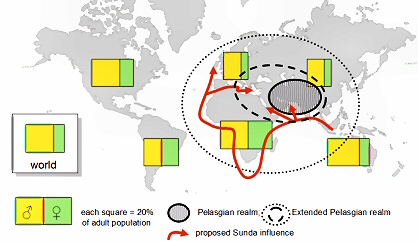 From
the presentation: continental patterns of child
abuse based on data from Stoltenborgh et al.
|
| |
|
|
| |
Faced with the task of compiling an uptodate
bibliography of my writings in the field of
medical anthropology (in the context of the
reprint of my text The Infancy of Edward
Shelonga), I found that many of my older
texts have not been available on the Internet yet
-- medical anthropological, and other. I have
sought to remedy this situation with an auxiliary
webpage NOW
UPLOADED (click here) or here . |
|
|
| |
the year 2023 begins above this
blue beam |
| December 2022 |
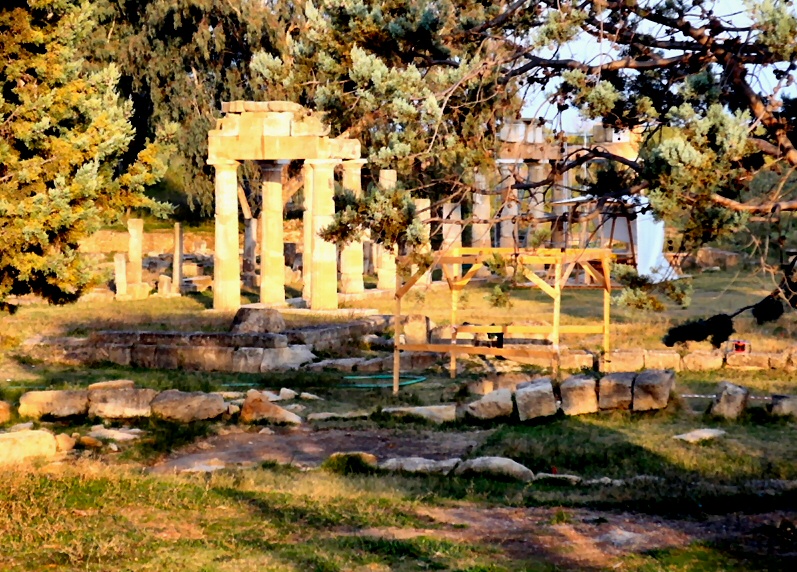 remains of the
temple of Artemis Brauronia Brauron,
Eastern Attica, Greece, 2010 CE -- probably a
centre of
female puberty rites in Greek Antiquity, where
the novice
girls took the identity of bear cubs attended to
by Artemis
as the Bear Mother
|
In the context of finalising my recent
synthetic account of Africa Intercultural (2022)
I became aware of the fact that over the decades
I have extensively discussed Female Puberty Rites
(FPRs) among the Nkoya people of Zambia, and
their striking parallels in North American
ethnography (especially among the Apache and
related peoples) – but have so far never
stopped to consider the wider global distribution
of this highly significant and intriguing
ceremonial complex. While containing many
revealing and hitherto unpublished details and
discussions on female puberty rites among the
Nkoya, and a large number of relevant photographs
(as well as a very extensive bibliography of FPRs
worldwide), the aim of the present presentation
is primarily to provisionally fill this gap.
However, my trouble with PowerPoint Presentations
is: one is always tempted to add more text and
more pictures, whereas the process of revising an
uploaded PowerPoint is too tedious to repeat all
the time. So for the time being we stay with the
present version, which in the course of a few
weeks already went through several revisions.
Apart from adding a few salient points (such as
Nkoya women's belief that male semen is
indispensible for women's health; or the amazing
fact that 10-year old girls from the neighbouring
Kaonde group have been reported in the older
literature (Melland, Witchbound Africa)
to go sexual man-hunting far from home and far
from parental control!), what I would have liked
to do is: enter into a fuller discussion of the
Nkoya official ideology surrounding male sexual
advances. It is true that, among the Nkoya, every
intercourse legally requires the female partner's
explicit consent for this specific occasion. But
it is also true that women feel they can hardly
refuse a man's initiative unless on a good
pretext (such as the polluting and lethal effect
of menstrual blood...), which adds to female
submissiveness and reinforces the appearances of
Female Puberty Rites as, after all, an instrument
of male domination. I have the impression that
the contradiction between the two principles
reveals a historic phase difference: the legal
dimension presents a traditional pre-modern
perspective with implicit female dominance --
reflecting a time (mythical, but I believe also
historical, see my1992 book Tears of Rain)
when women were clan leaders, even kings; the
almost automatic yielding to male advances
reflects a recent, modern power shift between the
genders, But much more reflection and argument
remain needed on this point
Now available:
van Binsbergen, Wim M.J.,
2022, Female puberty rites: Global
distribution and historical reconstruction
– a first attempt starting from the
Nkoya people of Zambia (click for PDF)
and click here for the
attending extensive bibliography
In the process I have also
returned to my first poem on Nkoya purberty
rites, as published in my first official book of
poetry, LEEFTOCHT (1977); click here for the pdf of that poem
|
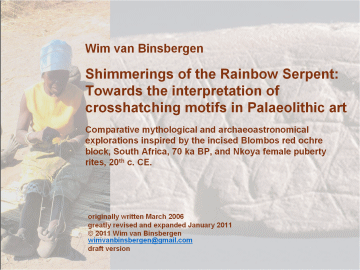 Wim van
Binsbergen's earlier (2011) attempt to deal with
Nkoya female
puberty rites in a long-range perspective (click for PDF)
|
|
| September-November 2022 |
|
|
Earlier it was reported in this website that
Wim van Binsbergen had been asked to contribute
to a collective volume on interculturality, to be
edited by Michael Steppat, of Bayreuth
University, Germany. Meanwhile that paper has
been written and that book has gone to the press.
Considering, however, Michael's enthusiasm for
Wim's text (he called it 'a stunning
achievement'-- perhaps mainly because he had had
to wait for it for so long...), Wim decided to
revamp the (already exceptionally long) text of
that paper with more bibliography, a very
personal introduction, and a photo essay, and
publish it as a book in its own right -- for some
years now he has felt the need for a smallish
book that would not deter potential readers in
the same way as the several tomes of 500+ pages
he has published over the past decade. Moreover
the present argument in several ways takes
decisive steps forward in the approach to
interculturality, and proposes solutions for some
of the aporias in this field, as compared to
Wim's earlier major texts on the topic: Intercultural
Encounters (2003), and Vicarious
Reflections (2015). Now
published:
van Binsbergen, Wim M.J., 2022, Africa
intercultural: Theory, methodology,
description, Hoofddorp: Shikanda, Papers
in Intercultural Philosophy and
Transcontinental Comparative Studies, No. 37,
ISBN / EAN 978-90-78382-54-6, 165 pp [ cleck
for PDF ]
|
|
| |
|
|
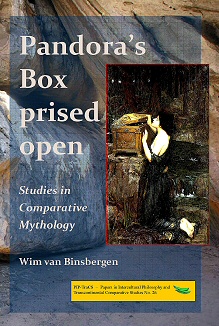
Wim van Binsbergen's latest
contribution to comparative mythology (2022),
amply illustrating his (eclective) use of
structuralst methods of myth analysis (click on
image for access to the book's PDF) |
In 1975-1977 Wim van Binsbergen acted in the
Leiden chair of Sociology and Cultural Studies in
Africa -- previously occupied by John Beattie,
and soon to be occupied by Adam Kuper. Prior to
this episode he had had hardly any contact with
Leiden, neither with the Department of
Anthropology there, nor with the (then still
inter-university, national) African Studies
Centre there. His main Leiden contact had been
the anthropologist Hans van den Breemer; Wim and
Hans had both served on the board of the
Netherlands Association of Studies in Cultural
Anthropology (KULA), 1966-68. Just returned from
three years of teaching and fieldwork in Zambia,
still in the clutches of the extremely traumatic
medical experiences he and his family, and
especially the host population had to go through
during rural fieldwork among the Nkoya people,
and enjoying a writing-up stipend at his old
anthropology department at Amsterdam University
(a hot-bed of anti-structuralist prejudice), in
September 1974 Wim was invited to attend a
secluded seminar of Leiden structuralists. The
next day he composed, in Dutch, a passionate long
letter to Hans, strongly denouncing -- true to
his Amsterdam training -- structuralism as well
as (and this was also an Amsterdam hobby-horse)
cultural relativism. The letter is still
interesting for a number of reasons. Admirably,
Hans took it in his stride, and he and Wim
remained friends, co-operating closely and
productively, for instance, on the board of the
Netherlands Association for African Studies,
1990-1993. But as was to be expected: soon Wim,
with his life-long fascination for myth, had to
admit that structuralism constituted an
indispensable part of the anthropological
theoretical and methodological toolkit, and came
to rely more and more on lévistraussian
structures in his own analysis of myth in North
Africa, Zambia, and worldwide. And as it turned
out in retrospect, all the major themes which
rather unexpectedly were to emerge in Wim's work
are already preluded upon in this letter --
including Marxism, intercultural philosophy, the
emphasis on the fundamental unity of humankind,
the effort criterium for the
construction of valid intercultural knowledge,
the distinction (very much at the heart of
classic anthropology) between emic and
etic -- and the insistence on transcending
that distinction by incorporating transcultural
elements in the researcher's personal life and by
unconditionally accepting local roles against
local conditions. Wim kept this seminal but
immature text totally obscure for half a century,
and only now brings it out, thoroughly annotated,
and with very extensive bibliography.
now made available:
van Binsbergen, Wim M.J., 2022,
'Structuralisme en cultuurrelativisme: Naar
een antropologie van het hart (een ingrijpend
geannoteerde en van literatuurverwijzingen
voorziene uitgave van een concept uit 1974)'
[ click for PDF ]
|
|
| |
|
|
 |
| |
| the cover photograph
depicts one of the minor protagonists in
the extended case (my adoptive sister's
daughter, who often played on my lap as a
baby), nearly four decades later (2011),
with her latest child -- in front of the
Rural Health Centre that arose as a
positive result of the health
tribulations recounted in the extended
case history |
|
In view of the overwhelming presence of the
medical field in the current lives of Patricia
and Wim van Binsbergen, Wim decided to reprint as
a book his seminal 1979 long article on 'The
infancy of Edward Shelonga' (called 'a classic of
medical anthropology' by Sjaak van der Geest
(1996), the central figure in medical
anthropology in the Netherlands 1975-2015). For
this occasion, the book was extensively revised
and expanded, and has been given a long new
Preface, in which the surprisingly decisive
catalytic role van Sjaak van der Geest in Wim van
Binsbergen's anthropological career is
highlighted, Wim's seminal relationship with
several other colleagues is likewise discussed in
some detail, and (especially in long new
footnotes) the relevance of much of Wim's
subsequent research 1979-2023 for this book's
argument is highlighted. Also a long list is
appended of Wim's titles in the field of medical
anthropology and closely related fields. Throughout
this new edition, in the text as well as in the
illustrations, the considerable extent is
highlighted to which Wim, in the course of nearly
half a century, has traded his original identity
as an inhabitant of the North Atlantic region,
for that of a Zambian Nkoya with extensive kin
relations among that ethnic group, a social and
political actor close to the throne of the
traditional leader Mwene Kahare, and a certified
and practicing African traditional healer; these
perspectives have greatly informed his more
recent work in globalisation, comparative
mythology, intercultural philosophy, and the
History of Ideas.
The original, 1979 version of this long case
study was dedicated to the late lamented
biophysicist Henny van Binsbergen-van Rijn
(1936-2019), Wim's first wife and his loyal and
resourceful companion in the traumatic 1973-1974
rural fieldwork among the Nkoya of Zambia (during
which she faced very severe medical challenges
herself); the 2023 reprint is dedicated to
Henny's memory, but also to the nursing, medical,
and housekeeping staff of the Spaarne Gasthuis
hospital (location Haarlem South, who, at this
institution's intensive case unit, have been
fighting for months, and with increasing success,
in order to restore and preserve the health of
Patricia van Binsbergen-Saegerman, Wim's wife
since 1984, and his loyal and resourceful
companion in fieldwork and analysis in many parts
of Africa, during the last decade also in Asia,
Oceania and North America
Now published:
van Binsbergen, Wim M.J., 2023,
The Infancy of Edward Shelonga: An extended
case highlighting the interplay of
traditional and modern health care among the
Nkoya people, Zambia, 1970s, Hoofddorp:
Shikanda, Papers in Intercultural Philosophy
/ Transcontinental Comparative Studies
PIP-TraCS, No.27, ISBN / EAN
978-90-78382-55-3, 213 pp, with 3 maps, a
genealogy, 21 photographs, extensive
bibliographies, and a full index of proper
names (click for
PDF); distribution of the new print version
via Amazon.com
|
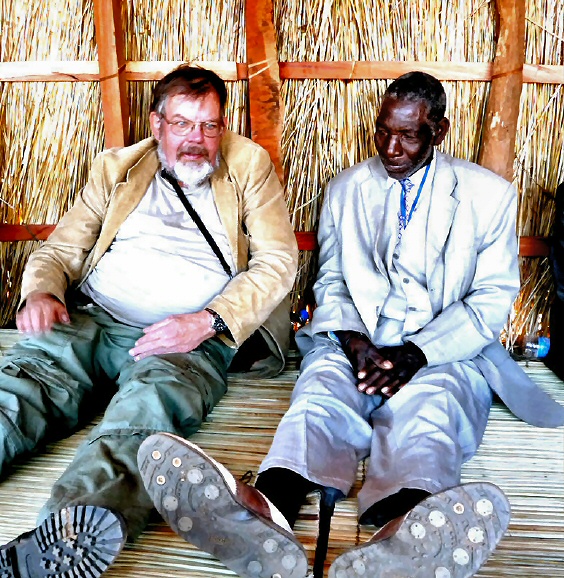 Forty
years after the inception of their close
relationship, this picture shows Muchati [7] and
Tatashikanda (the author, left, in one of his
more athletic poses) waiting for an audience with
Mwene Mutondo, one of the three other royal Nkoya
chiefs besides Mwene Kahare, in the temporary
royal court erected for the occasion of the
Kazanga Cultural Festival, Kaoma District,
Zambia, 2011.
|
| |
|
|
| |
Among the fieldwork which Wim van Binsbergen
conducted during his first period in Zambia,
1971-1974, was a sociological survey of religious
organisations Zambia's capital, Lusaka. This
research was funded by the Universdirty of
Zambia, which paid for the purchase of a
motercycle (the Lusaka area including informal
settlements was already huge and there was very
little public transport), and the payment of a
research assistent in the person of Wim's student
Pat Mutesi, who later became a sociologist in his
own right. Only a few published texts
specifically originated in this specific survey,
but in familiarising Wim with the cntemporary
religious scene in Zambia, and the resources
available for its study, it was one of the bases
for Wim's seminal book Religious Change in
Zambia (1981). click here for a preliminary
field report
after going through the trouble of preparing a
new PDF for this 50-years old report, I found to
my dismay that I had already uploaded it here
earlier, as:
http://www.quest-journal.net/shikanda/publications/lusaka_churches_1972.pdf
|
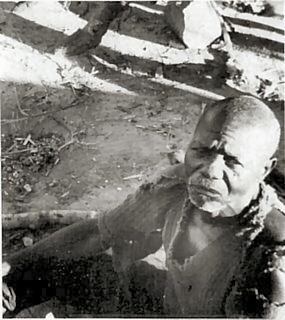
Headman Lubumba, a witchfinder and
ecological prophet among the present-day Nkoya
(Njonjolo, Kaoma district, 1973) |
|
| May-August 2022 |
 |
Now published:
van Binsbergen, Wim M.J., 2022, Pandora's
Box Prised Open: Studies in Comparative
Mythology, Hoofddorp: PIP-TraCS, No. 26,
numerous illustrations and tables,
bibliography, indexes, 700 pp. -- ISBN / EAN
978-90-78382-51-5
click
here for access to the PDF
about this book (blurb):
| This book brings together 21 of the
author’s contributions (some of them
published here for the first time) to the
field of the New Comparative Mythology
since the early years 2000, when this
discipline (long considered obsolete and
ideolog ically com prom ised through its
association with such arch-conservative
scholars as Frazer, de Vries, Eliade,
Dumézil, Jung, etc.) was successfully
and convincingly revived by the renowned
Sanskrit scholar, German-born Michael
Witzel (Harvard Mass., USA, formerly of
Leiden, the Nether lands). Having been
preoccupied with the study of myth
throughout his intellectual life, Wim van
Binsbergen (*1947, Amsterdam, the
Netherlands) initially concentrated on
the literary uses of myth by such
novelists as the Russian-American
novelist Vladimir Nabokov, and the
Belgian novelist Hugo Claus; later he
extended his analyses to the
socio-political use of myth in North
Africa and sub-Saharan Africa, as as
aspect of his ethno-historical and
ethnographic fieldwork data collected in
these regions since the late 1960s. In
mid-career his focus shifted from
Africanist to globalist, and from
ethnography to long-range cultural
history and inter cultural philosophy.
This book testifies to the rich insights
to be gathered at the intersection of
these cross-fertilising fields of
research and reflection. |
|
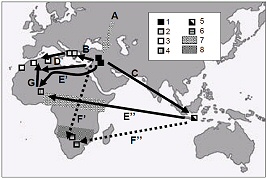 Fig
19.8. Proposed selective reconstruction of the
history of ecstatic religion from the Upper
Palaeolithic onward
|
| |
|
|
 |
During this period, Vol. I of Wim van
Binsbergen's 2-volume study of popular Islam and
social organisation in the highlands of N.W.
Tunisia finally appeared; Volume II is to follow
within a few months Now
published:
van Binsbergen, Wim M.J., 2022, Religion
and social organisation in north-western
Tunisia, Volume I: Kinship, spatiality, and
segmentation, Volume II: Cults of the land,
and Islam, Papers on Intercultural
Philosophy / Transcontinental Comparative
Studies, Hoofddorp: Shikanda, numerous
figures and tables, bibliography; ISBN
9789078382522 (click for PDF)
|
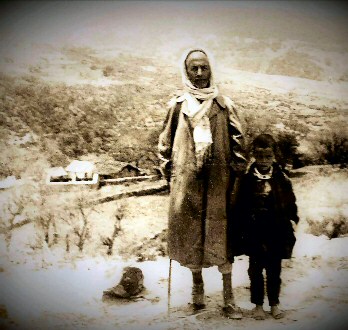 |
The venerable Amer bin
Mabruk, a man of great traditional
influence and knowledge, posing with his
grandson, in the village of Hamraya,
KHumiriyya, 1968 (which is when the bulk
of the data for this book were collected)
|
|
| |
|
|
 Koenraad Stroeken
|
Ever since his work on Religious Change
in Zambia (1981; also as Google Book), since
his work as founder / head of the Department of
History and Political Developments (African
Studies Centre, Leiden, Netherlands, 1980-1990),
and his various state-centred books and edited
collections including Tears
of Rain (1992) right through to his
recent book co-authored with Martin Doornbos (Researching
Power and Identity in African State Formation,
UNISA Press, Pretoria, South Africa, 2017),
Wim van Binsbergen has taken a close interest in
the state in Africa. One of Wim van Binsbergen's
close academic contact over the decades, Koenraad
Stroeken (one of the last PhD students of the
late lamented Renaat Devisch of Louvain
University, Belgium), now Professor of
Anthropology at Gendt University, Belgium, has
initiated one of the extended discussions for
which the journal Current Anthropology has
been famous. Wim was invited to submit a comment,
entitled
'Endogenous state formation in Central Africa?';
click here for a preview, which posits a
number of apparent requirements for state
formation, but the scope was too limited to enter
into a discussion of violence, the monopoly over
which to many (cf. Max Weber, 1919,
Wirtschaft und Gesellschaft) has been the
defining hallmark of the state |
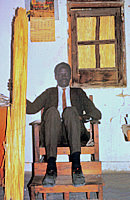 |
King Mwene Kahare
Kabambi, posing in state in his palace,
Njonjolo, Kaoma, Zambia, 1977; he holds a
rolled-up reed mat, which is considered
to be the emblem of the Mashasha section
of the Nkoya people (which he is
heading). Probably the reed mat is in
commemoration of royal mat burials
(another trait which the Nkoya have in
common with the Ancient Egyptians -- the
latter's royal title 'She of the Reed and
the Bee'  also returns in
Nkoya traditions of kingship); according
to oral traditions, when the Nkoya were
expelled from the Zambezi Flood Plain (by
the closely related Luyi people now known
as Lozi), they carried their royal
remains with them in reed mats also returns in
Nkoya traditions of kingship); according
to oral traditions, when the Nkoya were
expelled from the Zambezi Flood Plain (by
the closely related Luyi people now known
as Lozi), they carried their royal
remains with them in reed mats |
|
|
| April 2022 |
| |
|
|
| |
|
|
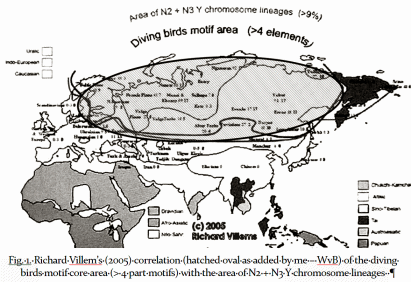 |
In the last few months, Wim van Binsbergen
has combined work on his books on Tunisia with
the preparation of a collection of his papers on
Comparative Mythology, and a Netherlands-language
book on his anthropological work during the first
half of his career. In the process, it turned out
that, in his 2010 paper (Harvard / 4th Annual
Conference of the International Association for
Comparative Mythology) on the heroes in Flood
myths, the detailed report on statistical
associations of heroes in his global database on
Flood myths (essentially compiled by Mark Isaak,
2006) was still insufficiently belaboured to
deserve a place in the projected book on
Comparative Mythology, and was removed from the
manuscript. This yielded, as an intermediate
product: Now
published:
van Binsbergen, Wim M.J.,
2022, 'A selection of statistically
significant associations found when, in a
data base on Flood myths world-wide, each
hero-related variableis cross-tabulated
against all non-hero-related variables', 94
pp; click here for PDF
|
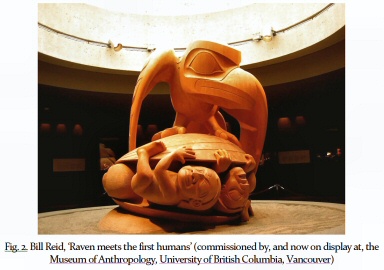 |
|
| March 2022 |
|
| January / February 2022 |
| |
|
|
| |
|
|
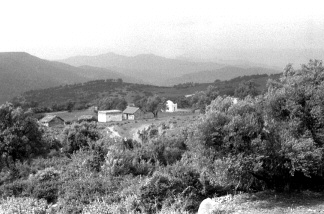 The centre
of the village of Sidi Mhammad, with the
characteristic domed shrine sacred to the local
saint Sidi Mhammad Jr, 1968
|
In 1968 Wim van Binsbergen conducted his
first ethnographic and ethnohistorical fieldwork,
in the highlands of North-western Tunisia. His
writings on that basis are mainly collected in
the webpage Historic
Berber Culture, included in the present Shikanda
website. Even after more than half a century,
he has not come round to finalising his 2-volume
monograph entitled: Religion and social
organisation in north-western Tunisia, Volume I:
Kinship, spatiality, and segmentation, Volume II:
Cults of the land, and Islam. Meanwhile
there has been a constant trickle of shorter
texts coming out of this project, most recently:
van Binsbergen, Wim M.J., 2022, 'The
participants’s perception of their
genealogy over time: Genealogical knowledge
and manipulation in the highlands of
North-western Tunisia, with special reference
to Murphy & Kasdan’s theory of
agnatic genealogies', 67 pp, with numerous
diagrams and tables (click here for PDF)
|
 an analytical
diagram derived from the text launched here
|
|
| |
2022 begints above this line |
| November 2021 |
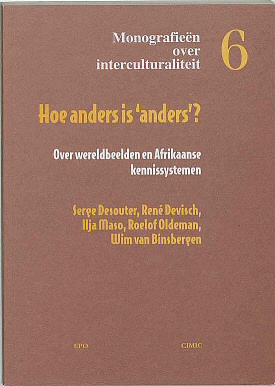 |
In 2000 nam Wim van
Binsbergen in Brussel, Belgie, deel aan een
conferentie over inclusieve wetenschapsbeoefening
georganiseerd door het Leo Apostel instituut
(organisatrice Nicole Note). De handelingen
werden spoedig gebundeld in een collectieve
uitgave van Monografieën over
interculturaliteit, Berchem/ Mechelen: EPO/ CIMIC
(Centrum voor Intercultureel Management en
Interculturele Communicatie). Omdat de huidige
website pas in 2002 werd ingericht, is Wims tekst
tot nog toe niet op het web beschikbaar geweest.
Bij dezen dan:
van Binsbergen, Wim M.J., 2000,
‘Naar een inclusieve
wetenschapsbeoefening in de
sociaal-wetenschappelijke studie van
Afrika’, in: Decouter, S., Devisch, R.,
Maso, I., Oldemans, R., zzz& van
Binsbergen, W., 2000, Hoe anders is
‘anders’: Over wereldbeelden en
Afrikaanse kennissystemen, Monografieën
over interculturaliteit no. 6, Berchem/
Mechelen: EPO / CIMIC (Centrum voor
Intercultureel Management en Interculturele
Communicatie), pp. 55-69 (klik voor PDF)
>>
Exponent of an African knowledge system: The
Ila prophet Mupumani, a leper who ca. 1915
started an ecological prophetic movement with
considerable if short-lived impact throughout
Western Northern Rhodesia and surrounding
countries (see: van Binsbergen, Religious Change
in Zambia, 1981 -- click for access as Google Book)
|
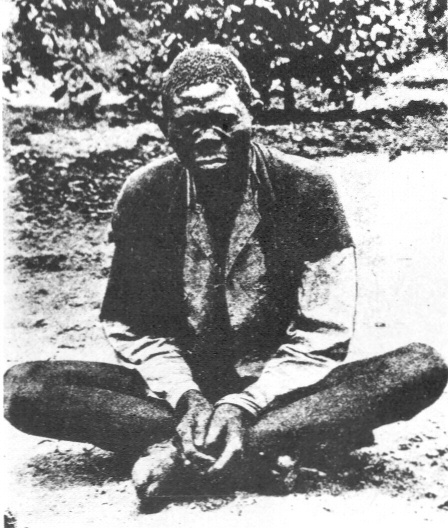 |
| |
|
|
|
Now published:
van Binsbergen, Wim M.J., 2021, 'A
Century of Dialogue around Durkheim as a
Founding Father of the Social Sciences', Culture
and Dialogue, 9: 167–200 (click for
PDF)
Please note: due to
overanxious (but ignorant) copy-editing on the
part of the journal, and the author's inability
to oversee the final proof-reading because of
recent major heart surgery, the printed text
contains a blatant error: the suggestion that
Durkheim (who never set foot in Australia, but
eagerly followed the then current ethnographic
literature on Aboriginal life, and in the decade
and a half prior to the publication of Les
Formes Elémentaires (1912) published
several pathbreaking syntheses on this field)
actually and personally did fieldwork on
Australian totemism. Alas, such an error is
undeservedly detrimental to whatever scholarly
authority the rest of my text might lay claim to.
This article is largely based on Wim van
Binsbergen's recent (2018) book: Confronting
the sacred: Durkheim vindicated through
philosophical analysis, ethnography, archaeology,
long-range linguistics, and comparative mythology,
Hoofddorp: Shikanda Press, 567 pp., ISBN
978-90-78382-33-1, also at: http://www.quest-journal.net/shikanda/topicalities/naar%20website%208-2018/Table_of_contents.htm
|
 |
| |
|
|
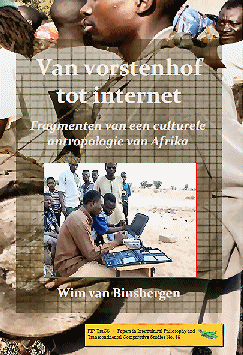 |
Nu gepubliceerd:
Binsbergen, Wim M.J. van, 2021,
Van vorstenhof tot internet: Fragmenten van
een culturele antropologie van Afrika,
Hoofddorp: Shikanda, PIP-TraCS – Papers
in Intercultural Philosophy and
Transcontinental Comparative Studies –
No. 18, 700 pp., ISBN 928-90-78382-50-8, EUR
80.00; klik hier voor vrije toegang tot een
ruwe versie van de PDF (er is kennelijk nog
wat werk aan de bibliografie)
Wim van Binsbergen concipieerde
dit Nederlandstalige wetenschappelijke boek (het
meeste van zijn omvangrijke wetenschappelijke
oeuvre is in het Engels) in eerste instantie in
het midden van de jaren 1990, en voegde er
vervolgens grote hoofdstukken aan toe die zijn
overgang van antropologie naar interculturele
filosofie markeren. In de inleiding legt hij uit
waarom publicatie zo lang op zich heeft laten
wachten (klik hier; tevens een overzicht van Wims
voornaamste onderzoeksresultaten in de laatste
kwart eeuw ), naast de
vanzelfsprekende reden dat een hedendaags
antropoloog geen enkele eer inlegt met een
Nederlandstalige publicatie en daar geen voorrang
aan kan verlenen zolang hij in loondienst is.
de afbeelding
rechts analyseert de invloed van buurrelaties op
veldwerkcontacten in een volksbuurt in
Francistown, Botswana --
een van Wim van Binsbergens veldwerklocaties
|
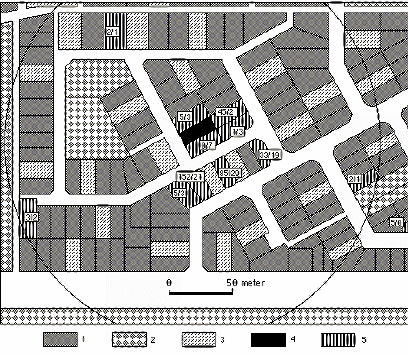 |
| |
|
|
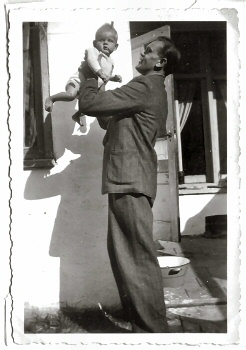 Wim van Binsbergen als baby, met zijn
vader,
Amsterdam, 1948
|
In het voorjaar van 2021
legde Wim van Binsbergen in zijn nieuwe
dichtbundel Kinkerbuurt
1947-1960 getuigenis af van zijn
pijnlijke kinderjaren. In het voorjaar van 1991
stierf zijn vader. Die werd begraven te Didam,
Gelderland, waar hij voor zijn pensionering enige
jaren werkzaam was geweest. Op de begrafenis
sprak de zoon een grafrede
uit, die nu beschikbaar gemaakt wordt (klik voor PDF).
Recente kleine toevoegingen in de tekst
verschijnen in cursief. |
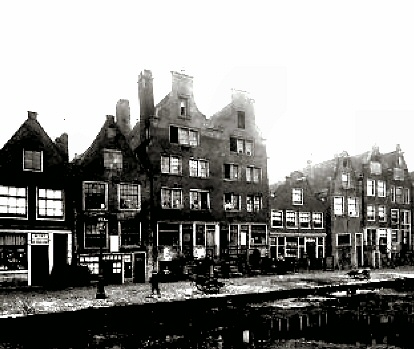 Het
beruchte Fort van Sjako ('Jacob', Fr.), aan de
Elandsgracht, Jordaan, Amsterdam, -- een Dreigroschenoper-achtig
roversnest waar (volgens de familietraditie
althans) Wim's grootmoeder van vaderskant eind
van de 19e eeuw werd geboren op een per uur
gehuurd bed; door de Spaanse Griep van 1918 werd
zij weduwe, en zij sloofde zich af als
garnalenpelster en werkster, maar al haar vijf
zonen kregen een voltooide beroepsopleiding,
terwijl de Jordaan vooral ongeschoolde arbeiders
voor de haven leverde
|
| |
|
|
| Professor Michael Steppat at
Bayreuth University, Germany, is now preparing a
major volume on intercultural research, with over
20 international contributors. Wim van Binsbergen
has been commissioned to contribute a chapter on
interculturality in Africa, as well as the book's
Preface. |
| |
|
|
| The spectacular invisibility of
the social sciences including anthropology in the
pressing societal issues of today (COVID-19,
public violence, climate change, energy crisis,
the rapidly declining legitimacy of the state in
the eyes of citizens, ethnic conflict, the
falling apart of the texture of civil society,
the increased power of organised crime, etc.) is
a reason of mounting concern for Wim van
Binsbergen. In 1987, he presented a paper at the
Centre for African Studies, Edinburgh, Scotland,
UK: 'Reflections on the future of anthropology in
Africa'. Although reprinted in his 2003 book
Intercultural Encounters, the text
was so far not readily available on this website;
click here for PDF of
the 2003 revised text including a postscript
2002. Revisiting that paper after 35 years, he is
now drafting an essay addressing this situation. |
| |
|
|
| In November
2021 is het dertig jaar geleden dat Matthijs
Schoffeleers, gepensioneerd na vele vruchtbare
jaren als hoogleraar aan de Vrije Universiteit VU
te Amsterdam, te Utrecht de bijzondere leerstoel
godsdienstantropologie aanvaardde. Bij die
gelegenheid sprak zijn voormalige eerste
promovendus Wim van Binsbergen (destijds
inmiddels hoogleraar aan de VU) een
rede uit die hierbij beschikbaar gesteld wordt. |
| |
|
|
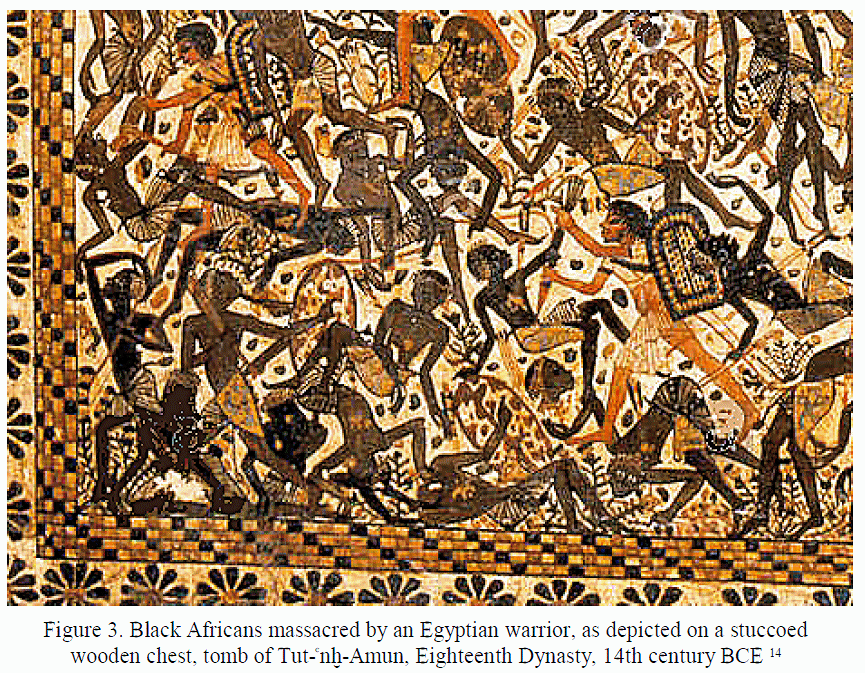 From my draft of Global
Bee Flight: Black Africans trempled
underfoot by Egyptians on a funerary item of
Tut-ankh-Amun -- not exactly what one would
expect from an Afrocentrist position
|
GLOBAL BEE FLIGHT. In the two
entries immediately below, I present two
unpublished book drafts which were largely
rendered obsolete by my later research and
publications, but which still so much influenced
the orientation of my research in later years
that I find it difficult to discard these drafts
altogether. The same applies a fortiori to
my first attempt at long-range transcontinental
analysis, my book draft Global Bee Flight --
originally written as an attempt to mitigate the
vicarious Afrocentrism which Martin Bernal -- on
second thoughts -- had brought to his Black
Athena thesis. My Global Bee Flight was
repeatedly announced from the late 1990s on, but
never materialised.
In preparation for this
book I familiarised myself with the Ancient
Egyptian language and (hieroglyphic) writing
system, and absorbed a large part of the
extensive Egyptological literature. All of this
was indispensible as preparation towards my work
on Ethnicity in Mediterranean Protohistory
(2011, yielding a major archaeological
publication co-authored
together with the late lamented Fred Woudhuizen): the main contemporary documents on
the Sea Peoples of the Late Bronze Age derive
from Egyption inscriptions. In the more than
twenty years since Global Bee Flight was
drafted, I have cannibalised part of the book's
argument for my book Before the Presocratics
(whose starting point is the Zambian Nkoya clan
system, hinging on a catalytic, Chinese? version
of the cosmology of cyclical element
transformation). But whenever I returned to the
1998 draft, I found that the book's Egyptology
leaves too much to be desired (my attempted
translation of the famous 1st dynasty Abydos
Label turns out to be amateurish, even untenable,
in the light of rival attempts available in the
literature); that the subsequent growth of my
insight into the Black Athena problematic
necessitates a lot of rewriting; that my
treatment of human somatic difference as one
possible basis for social classification
('Blackness') does not take enough distance from
the obsolete genetics of race in the context of
the Black Athena debate and after, well
into the third millennium; and that my emerging
long-range methodology of transcontinental
research has been improved so much in nearly a
quarter of a century as to render my attempts in Global
Bee Flight no longer worthy of publication
-- not even as an obscure web page. Even so, the
draft contains an intriguing, sustained argument
on the emergence of the Early Dynastic state (inspired by the models of state
formation I have explored in sub-Saharan Africa, in part with Martin Doornbos), on diffusion, on the Black Athena
debate, on bee symbolism (including the puzzling
Ancient Egyptian royal title 'She of the Reed and
the Bee'-- nswt-bit.  ,
and on Eurasia as a cultural region. ,
and on Eurasia as a cultural region.
These are still highly
interesting topics. Yet, with a plethora of
other, more promising projects on my hands, and
serieus health issues, I doubt whether I will
ever come around to a proper publishable revision
of the Global Bee Flight draft. |
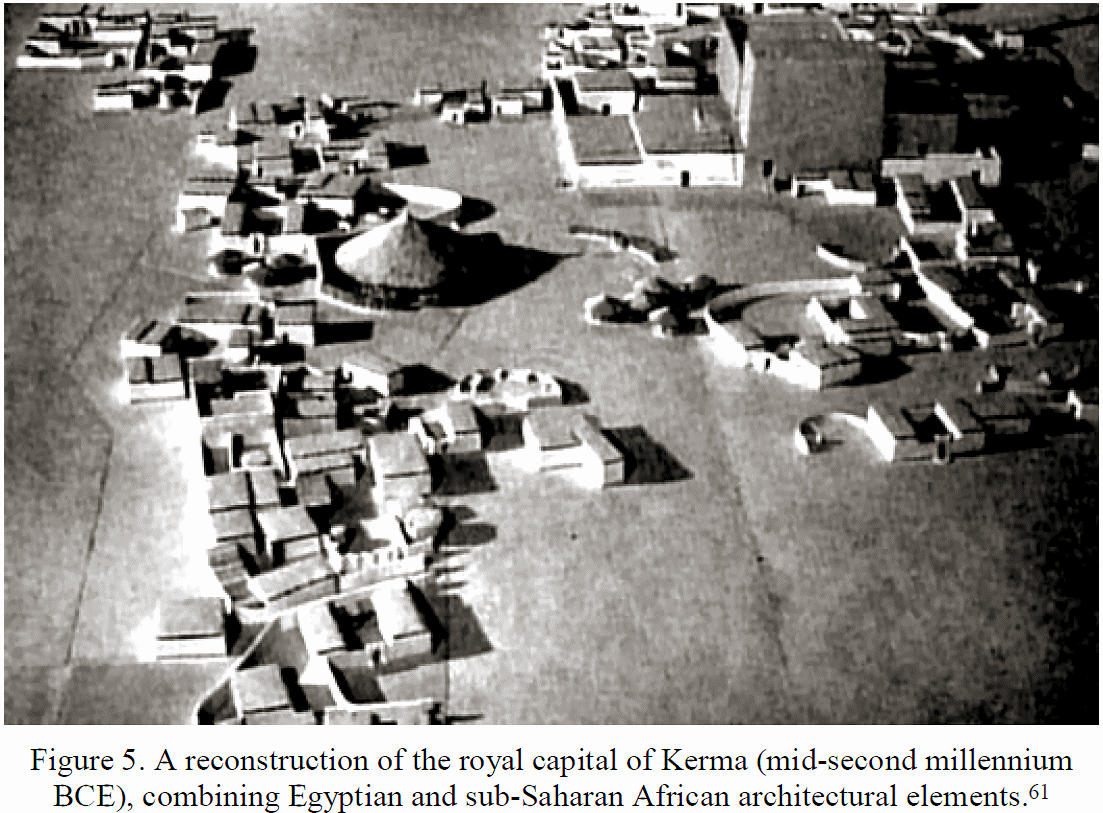 From my draft of Global
Bee Flight: reconstruction of Kerma, the
capital of Meroë, meeting-point of Eguyptian and
sub-Saharan African themes
|
| |
|
|
 |
FROM AN AFRICAN BESTIARY TO GLOBAL SCIENCE?
The entry immediately below presents an
unpublished book draft now finally resurrected
from the computer / hard disk grave. Another such
research project on transcontinental comparison
led to a short book draft:
van Binsbergen, Wim M.J., From an
African bestiary to universal science?
Cluster analysis opens up a world-wide
historical perspective on animal symbolism in
divine attributes, divination sets, and in
the naming of clans, constellations, zodiacs,
and lunar mansions, book draft 2001-2002-2004
(click for PDF)
An earlier version of this text
was already made available, in a clumsy format,
as a web page in the present website, at: http://www.quest-journal.net/shikanda/ancient_models/animal.htm . Since the early 2000s, I have
entertained ambitions to add some new data to the
data set and to slightly improve the mathematical
quality of the cluster analysis. This never
materialised since I was successively absorbed in
the writing of other books, duly reflected in
this website; inevitably, however, these books
built, in part, on the earlier results of these
unpublished book drafts. What particularly
discouraged me to publish a final version of the
present draft as a book, was the following
consideration: I gradually became aware of a
major ideological flaw in the 2001-2004 argument.
As also attested by my publications at the time
(including my contributions to the Black Athena
debate (see under:
August 2011); to a Paris, France, EHESS conference on
Afrocentrism (click on
the link and proceed to p. 175); and my critical analysis of the work of
Valentin Mudimbe),
around the year 2000 I was so enamoured with
Afrocentrism, that I believed that only by
recourse to an Afrocentrist, Africa-origin
hypothesis could I begin to explain the
transcontinental patterns emerging from my
'African bestiary to modern science' project. In
my subsequent transcontinental analyses, however
(which benefitted from my research, in
the meantime, on Mediterranean protohistory which
I had thoroughly explored together with the late lamented Fred Woudhuizen), my perceived focus of early cultural
history shifted (a) from sub-Saharan Africa to
West Asia ( / Egypt), and (b) to an awareness of
a transcontinental maritime network that
made for much greater connectivity, and for far
mor extensive feedback effects, than could ever
be accommodated by the naïve assumption of
diffusion from one identified focal origin.
Another reason why I am no longer satisfied with
this version is that it represents a much earlier
phase in my extensive study of comparative
mythology during the past decades and thus could
not benefit from my synthesis (e.g. 2006a; 2006b; 2010) of the
global history of myth which -- inspired
especially by Michael Witzel -- has formed the
backbone of much of my later work.
Meanwhile, a surprising and
most inspiring finding of the African
bestiary project was the strong suggestion
to the effect that African systems of clan
nomenclature, and divination sets (including the
South Central African basket oracle as described
by Turner and by Rodrigues de Areia; the
four-tablet oracle which has played such a great
role in my own work over the decades; and the
Nkoya clan system in Zambia, which I had studied
ever since 1972) had symbolically and
conceptually much to do with animal-centred
systems of religious symbolism, of astronomy
(notably in zodiacs and lunar mansions -- a lunar
mansion is a immutable section of heaven where
the moon will be situated for any one of the
27-28 days of its near-monthly cycle), and of
cosmology, in the rest of the Old World,
especially Ancient Egypt, the Ancient
Mediterranean (primarily the Aegean), the Ancient
Near East, and Ancient China. In such later books
as Before the Presocratics (2012) and Sangoma Science (2021) I have worked out these
relationships in greater depth and detail. In
that connection particularly the amazing
similarity came to the fore between the Nkoya
clan system and the globally wide-spread
cosmology of cyclical element transformation
(element A > B > C > A) but in the
specific catalytic Chinese version allowing for
the catalytic influence of a third element Z upon
these transformations. In the 2012 book, I argue
that this similarity is best explained by
assuming a substantial Chinese cultural intrusion
in South Central Africa in the middle of the 2nd
mill. CE (more on the transcontinental maritime
network and Chinese nautical expansion was
considered in my 2021 book and in my critical
studie of Menzies's hypothesis of Chinese global
exploration in theearly 15th c. CE).
|
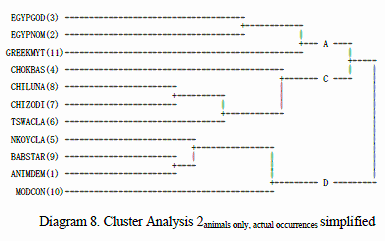 |
| |
|
|
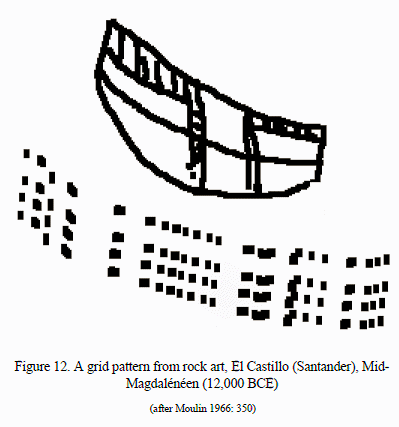 |
DIVINATION AND BOARD-GAMES. In
1994-1995 Wim van Binsbergen stayed at the
Netherlands Institute for Advanced Study in the
Humanities and Social Sciences (NIAS, Wassenaar),
as a member of the study group on Religion and
Magic in the Ancient Near East. Here he focussed
on the comparative and historical analysis of
geomantic divination within the Southern African
sangoma ecstatic cult, which he had studied in
Botswana from 1988 on. In this NIAS period Wim
was co-opted within the orbit of ludology, the
scientific study of games. Because of the
superficial parallels with geomantic divinatio n, he became particularly fascinated by
the mankala family of games which the
American researcher Culin had called 'the game of
Africa'. This kind of games is also known as wari,
nsolo, and bao, and besides
Africa has in fact an almost global distribution.
The game requires at least two rows of shallow
cups, along which tokens are raced, and captured,
according to intricate rules with amazing
mathematical implications. Repeated attempts to
design a model of transcontinental cultural
history in which the data around geomancy and
makala could be systematically interpreted, were
to have a decisive impact on all of Wim's
subsequent, transcontinentallly-orientated,
research. This led to a number of published
articles (to be found elsewhere on this website)
and several book drafts, among which Before the Presocratics (2012) and Sangoma Science (2021) have been the most accomplished
and conspicuous ones. Later he was to cast a
fresh look at these earlier analyses, in a revision (click here) which has menwhile been incorporated in
various book-length texts. Another draft
for a small book was never published but was
cannibalised for other publication projects in
the course of the years:
van Binsbergen, Wim M,J., 1997-2004,
Board-games and divination in global
cultural history: A theoretical, comparative
and historical perspective on mankala and
geomancy in Africa and Asia (click here
for PDF)
As a stepping-stone towards the
later, longer texts this draft may still be of
some interest, which is the reason why even at
this late hour it is made available here
|
 |
| |
|
|
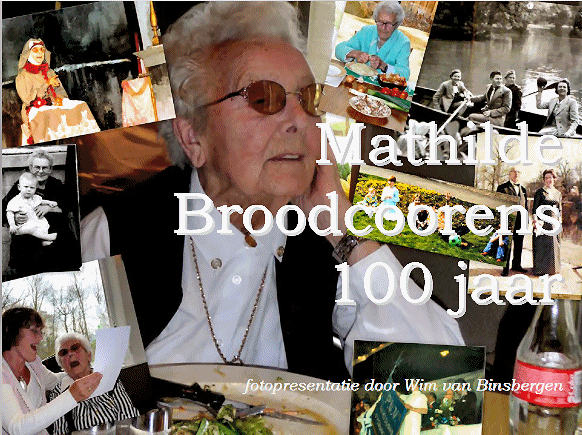 omslag van de presentatie
|
In 2013 stierf nabij
Dendermonde, België, op 102-jarige leeftijd Mathilde Broodcoorens,
de grootmoeder van moederskant van Patricia van
Binsbergen-Saegerman. Ondanks de grote afstand
(Wim en Patricia wonen in Nederland) namen dezen
het voortouw in de laatste jaren van Mathilde's
leven, en verzorgden onder meer de viering van
Mathilde's 100e verjaardag. Voor die gelegenheid
maakte Wim een uitvoerige fotorapportage van
leven en persoon van Mathilde, die nu eindelijk
beschikbaar gesteld kan worden op het Internet,
ten behoeve van Mathilde's vele nazaten en
verdere verwanten in België en Nederland: click
hier voor de PDF van de PowerPoint presentatie NB: om doublures te beperken zijn
diverse oorspronkelijke foto's uit de selectie
verwijderd; daarom wordt de nummering hier en
daar onderbroken
|
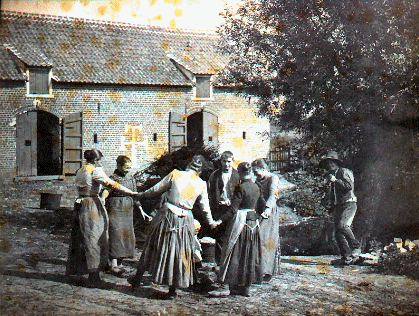 boerenvrouwen
dansen om een pasgebnoren baby in Geraardsbergen,
België, ca. 1900
|
|
| September-October 2021 |
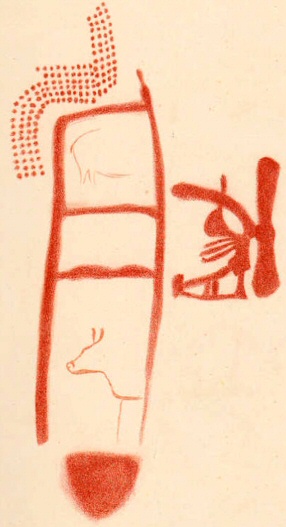
hand-copy of recently (2018)
discovered Neanderthal rock art |
Ever since Wim van Binsbergen's first work on
mankala board games and geomancy, in the 1990s,
has he pondered on the interpretation of the La
Ferrassie (Dordogne, France) Mousterian child
burial no. 6. Installments of successive
provisional approaches have been posted on this
website. A final statement is now ready for
publication:
van Binsbergen, Wim M.J., 2021, 'A
Neanderthal stellar map? The La Ferrassie
burial 6 block as a testimony of Neanderthal
astronomy and star-orientated religion'
|
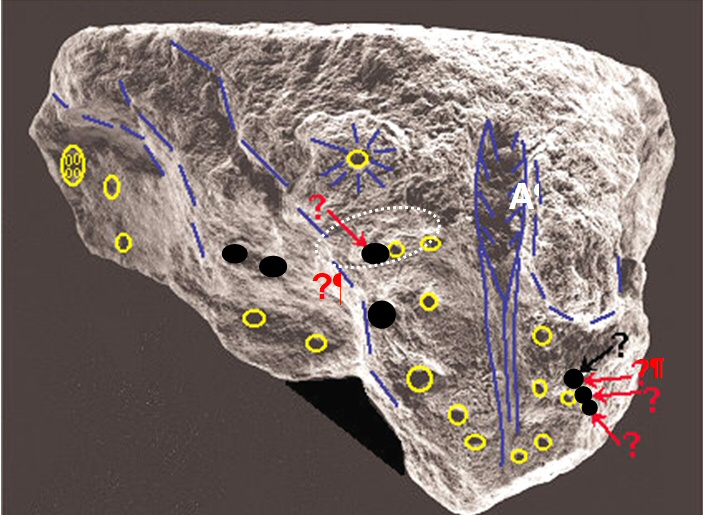 The La
Ferrassie cup-marked block interpreted as in the
present argument
|
| |
|
|
 |
Prompted by the sudden death of his 2011
co-author Fred C. Woudhuizen (see two entries
below), Wim van Binsbergen made a thorough
revision of the new edition of his 2021 book on
Joseph Karst. The Karst book is based on Fred and
Wim's 2011 magnum opus Ethnicity
in Mediterranean Protohistory. In the
process, Wim took the opportunity of dedicating
the new edition to Fred's memory click the following link
for the October 2021 revised version:
van Binsbergen, Wim M.J., 2021,
Joseph Karst: as a pioneer of long-range
approaches to Mediterranean Bronze-Age
ethnicity: A study in the History of Ideas:
New edition, vindicating Karst's four-tiered
model for the Bronze-Age Mediterranean,
Hoofddorp: Shikanda, Papers in Intercultural
Philosophy / Transcontinental Comparative
Studies No. 12, with numerous diagrams,
tables, and extensive index of proper names
(click on this link for free access to this
book)
|
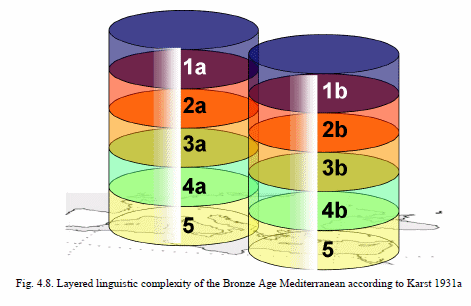 |
| |
|
|
 the pre-nuraghic
devotional site of Monte d'Acoddi, NW
Sardinia, often compared with Ancient
Mesopotamian
ziggurats from roughly the same period -- and
cited in
evidence of the Near Eastern provenance of some
early
inhabitants of the island
|
For a few weeks September / October 2021, Wim
and Patricia van Binsbergen made a short trip to
the Isle of Sardinia, Italy; having written on
Bronze-Age Sardinia (see entry immediately
below), it was mandatory that Wim visited some of
the principal local archaeological sites and
museums, but he was rather disappointed in his
high expectations; click
here for further photographs |
 Su Nuraghu at
Barumini, Sardinia, Italy. One of the most sur-
prising features is the paucity of passages /
staircases through
what is effectively a gigantic heap of rocks. As
meted out broadly
in the older literature, there is a superficial
ressemblance
with the massive central tower of the Great
Zimbabwe complex,
Zimbabwe, Southern Africa. However, the presence
of lingam /
yoni iconography at the latter site, in
combination with
ressemblances vis-à-vis the relic-holding towers
(cedi) of
South Asian Theravada Buddhist sacred
architecture, brought
Wim van Binsbergen to defend an Asian / 'Sunda'
interpretation
of Great Zimbabwe in some of his recent
publications
|
| |
|
|
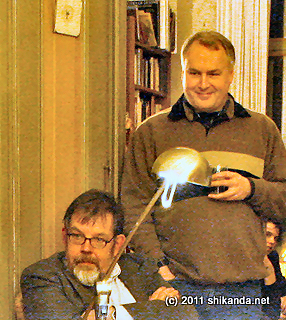 Fred (standing) and
Wim in 2007
|
While Wim van Binsbergen and his wife
Patricia were on a short trip to Sardinia, Italy,
Wim's close friend, co-author and former PhD
student Fred Woudhuizen died, at the tender age
of 62 years. Together they wrote the monumental
book Ethnicity
in Mediterranean Protohistory (2011, British
Archaeology BAR International Series No. 2256,
Oxford: Archaeopress). Click here for an
extensive obituary:
with special attention to the details of the
intensive collaboration between Fred and Wim over
the years.
|
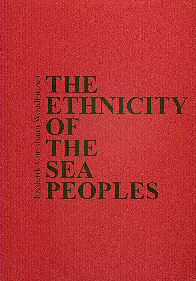 Fred's PhD thesis, 2006
|
|
| June - August 2021 |
 Emile Durkheim, 1859-1917
|
Now in the press: van Binsbergen, Wim M.J., 2021, 'A
century of dialogue around Durkheim as a founding
father of the social sciences', accepted for
publication in a special issue on French thought
of the journal Culture and Dialogue [
click for access to PDF ]
|
 cover of van
Binsbergen, Confronting the Sacred,
2018 (see below under 2018)
|
| |
|
|
| Mid-July 2021 Wim van Binsbergen
underwent major heart surgery in the Leiden
University Teaching Hospital. The aorta valve was
replaced. Also thanks to the lengthy and careful
preparation since late 2020, the operation went
smoothly and recovery was swift. We thank all
medical and nursing staff, relatives and friends,
for their essential support. |
| |
 |
|
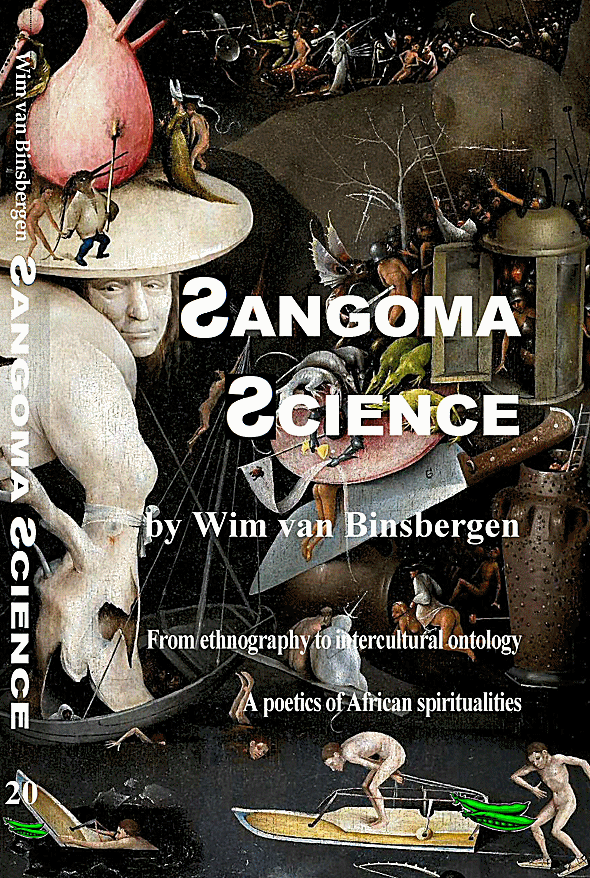 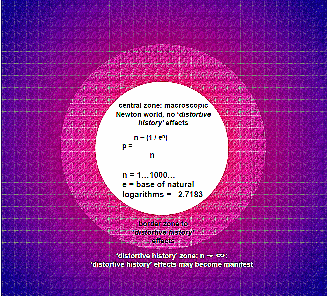
|
NOW PUBLISHED: A few
weeks before Wim van Binsbergen is due for major
heart surgery, he managed to send the first
proofs of his latest book to the printers:
Sangoma Science: From
ethnography to intercultural ontology: A
poetics of African spiritualities,
Papers in Intercultural Philosophy /
Transcontinental Comparative Studies, No. 20,
Hoofddorp: Shikanda Press, 481 pp., ISBN
978-90-78382-19-5, EUR80.00
the book's final connections have now been
completed, and the fulltext is available under
this link.
| This book's cover features the
following pointer: Black Thought Matters!
This is
the cult book for the 2020s! Starting out
as a poet, the author became an
anthropologist of African religion, then
an adopted African prince, then a
practising African diviner/healer (sangoma),
then a professor of intercultural
philosophy. The book testifies to the
vast knowledge, authority and wisdom thus
accumulated. In a passionate and deeply
personal way, the author traces his steps
over half a century and across most
continents, critically discusses theory
and method, shows how close the African
life world is to the New Physics, and
presents an ontology according to which
reality constantly oscillates between
Being and Non-Being. Thus this book
accounts for religion, God, evolution,
thought, time, the paranormal, the
world-creating nature of science, and the
time-warping / event-creating potential
of divination. The argument is set
against the background of the integrated
long-range perspective on global cultural
history, which the writer has helped
develop over the past decades.
|
the book's dedication, with the
pathos appropriate to this moment:
'To my children
(real and adopted) and grandchildren in the
Netherlands, among the Nkoya of Zambia, in
Botswana, and in Cameroon; I hope this book makes
them proud of their background and helps them
discover insights which otherwise they might well
spend a lifetime searching for in vain'
|
The book's blurb: The
exploration of ecstatic religion, in North, South
Central and Southern Africa, and the attending
historical and transcontinental ramifications,
have been constants in Wim van Binsbergen’s
work for half a century. He has graduated from
detached researcher to initiated and certified
local practitioner (‘sangoma’), from
empirical scientist to intercultural philosopher,
and from Africanist to globalist. In the process,
he has found that the various forms of ecstatic
religion with which he had acquainted himself,
constitute knowledge systems endowed with
relevance, validity, and truth in their own
right, not inferior to the North Atlantic
academic knowledge system that is privileged by
globalising modern science. However, although
repeatedly making such claims, so far he has
shunned from making the obvious next step:
articulating how (from these heterogeneous and
apparently contradictory approaches to the human
life world) a pluralistic intercultural ontology
might be constructed. This book is a (none too
conclusive!) attempt in that direction. Building
on the approaches to ecstasy and veridical
divination in his books Religious Change in
Zambia (1981; also Google Book), Intercultural
Encounters (2003, esp. Chs 5–8),
Before
the Presocratics (2012), and Vicarious
Reflections (2015); and
continuing the emphasis on spirituality of his
recent books Religion
as a Social Construct (2017) and Confronting
the Sacred: Durkheim Vindicated (2018;
also Google Book); the present argument is
organised in several parts. Part I dwells on the
methodology of research into ecstatic religion
through participant observation, with detailed
reference to two recent South African studies.
Part II takes up Edith Turner’s claims as to
‘the reality of spirit’, against a
background of both transcontinental ramifications
and theoretical / methodological scrutiny. Part
III raises the discussion above the individual
level and towards cosmological ontology,
contrasting two basic models: evolution or
eternal return. To what extent may perspectives
from outside the North Atlantic scientific domain
(notably the South Asian concept of kalpa,
‘aeon’, as an alternative to evolution)
lead to the desired intercultural ontology? This
question is explored with special reference to
Cremo & Thompson’s iconoclastic book Forbidden
Archaeology, 1993). The final chapter
explores the remarkable parallels between Dan
Brown’s book Origin (2017), and the
thought of Teilhard de Chardin. In conclusion,
the kaleidoscopic, capricious,
religiously-underpinned relation is affirmed
between human thought and the universe –
formulating a meta-cosmology and meta-theology in
which nothing is what it has been agreed to be,
and everything (even reality, the past, Being,
the thinking I, and God), constantly oscillates
towards its opposite and denial, under conditions
whose elucidation is still largely beyond our
grasp, but in which ritual turns out to play a
pivotal role. The argument is set against the
background of the integrated long-range view of
global cultural history, which the writer has
helped develop over the past two decades.
|
|
| February-May 2021 |
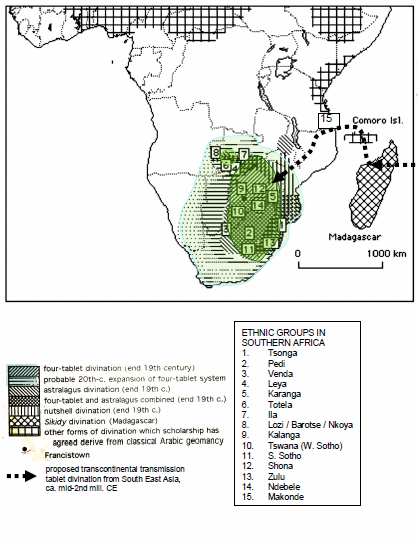 |
While a Fellow (1994-1995) at the Netherlands
Institute for Advanced Study in the Humanities
and Social Sciences (NIAS), as a full-time member
of the Study Group on Religion and Magic in
the Ancient Near East (conveners the
Assyriologist Tzwi Abusch and the Bible Scholar
Karel van der Toorn), Wim van Binsbergen sought
to produce a book on his comparative research
since 1990 into Islamic geomancy and
its ramifications in Africa and worldwide -- one
of humanity's principal divination methods with
which he had come into intensive contact during
fieldwork in Francistown, Botswana, from 1988
onwards. In NIAS's intellectually and
bibliographically stimulating new environment,
many unexpected steps were taken in the analysis,
and fundamental insights gained into
transcontinental and intercultural processes
which were to spawn a considerable number of
articles and book in the subsequent decades --
but the envisaged book itself so far did not
materialise. During the NIAS appointment, that
institution also made available funds towards a
provisional translation (by Mr Rafat Badwy with
the assistance of Wim van Binsbergen) of a
crucial Arabic medieval MS on Islamic geomancy,
Sheikh Muhammad al-Zanati's Kitab al-fas.l
al-kabir fi us.ul 'ilm al-raml. Already in
1995, this translation was announced as being in
MS, but it was never finalised nor circulated,
and Wim van Binsbergen went on to pursue the
lessons learned at NIAS in a wide range of other
projects and books. In the early Spring of 2021,
an investigator of West-African and Caribian
varieties of geomancy, Erwan Dianteill, Professor
of social anthropology at the Sorbonne (Paris
Descartes University), France, contacted Wim in
order to ascertain whether the translation was
finally available. That was for Wim the sign to
return to that project, the fruits of which may
be expected in book form within a few months. |

Duerer's depiction of the Jewish
medieval astrologer Messahalah; while the origin
of Islamic geomancy has been a mystery for
centuries, the present renewed research and
reflection now bring out that its origin may be
sought in a North Iranian milieu in the late 1st
mill. CE, where heterogeneous scholarly
influences met and cross-fertilised one another:
Hellenistic magic, Jewish magic, Islamic secret
sciences, Zoroastrianism, and the Chinese
worldview centred on the trigrams and the 64-fold
I Ching hexagrams. |
|
| Januari 2021 |
 |
In 2021, Wim van Binsbergen and Fred
Woudhuizen published their major contribution to
Bronze-Age Mediterranean studies:
Ethnicity in Mediterranean Protohistory
(Cambridge: BAR International Series 2256), 519
pp). More than could be expressed in this
volume, Wim's contributions to this book leaned
heavily on the little-known work of the Alsatian
(French / German) comparative linguist,
Karvelianist and Strassbourg professor Joseph
Karst (1871-1962). Meanwhile Wim drafted and
provisionally published a book-length study of
Karst, which now reaches its second edition. The
main innovation in this new edition is that in
its final chapter it addresses, and
empirically vindicates, Karst's
seminal model of the tiered ethnico-linguistic
structure of the Ancient Mediterranean. now published:
van Binsbergen, Wim M.J., 2021,
Joseph Karst: as a pioneer of long-range
approaches to Mediterranean Bronze-Age
ethnicity: A study in the History of Ideas:
New edition, vindicating Karst's four-tiered
model for the Bronze-Age Mediterranean,
Hoofddorp: Shikanda, Papers in Intercultural
Philosophy / Transcontinental Comparative
Studies No. 12, with numerous diagrams,
tables, and extensive index of proper names
(click on this link for free access to this
book)
|
 |
|
| |
the year 2021 begins above
this bar |
| November - December 2020 |
 Het ketelhuis van het Wilhelmina
Gasthuis, bij afbraak 1980-1982
|
| Nu gepubliceerd: Wim van Binsbergen, 2020, Kinkerbuurt
1947-1960: Twaalf autobiografische
gedichten, geïllustreerd, ISBN /
EAN: 978-90-78382-45-4, Hoofddorp:
Shikanda, 138 pp., EUR20 ; klik hier voor
PDF
klik
hier voor omslag
FLAPTEKST:
‘....Grotendeels onbekend
als dichter, ondanks meer dan een
dozijn bundels, en opname in de
canon-bepalende bloemlezingen van
zowel Komrij als Pfeiffer, werd
ik in 1947 geboren in de
Dichtersbuurt / Kinkerbuurt. Ik
woonde er tot 1960. De
Kinkerbuurt betekent voor mij een
afgesloten archief aan beelden en
gebeurtenissen die mijn
kindertijd smartelijk hebben
bepaald en die in mijn leven en
teksten voortdurend opspelen.
Ik heb de Kinkerbuurt de laatste
tientallen jaren nauwelijks nog
bezocht tenzij in tekst. Toen ik
laatst een fotoboek oppikte over Amsterdam
Oud-West realiseerde ik me
dat onder mijn afkeer en
verdriet, een liefdevolle
fascinatie ligt voor wat tot mijn
13e toch gewoon mijn wereld is
geweest. In deze bundel worden
voor mij belangrijke plaatsen en
personen benoemd. Ik kan mij nu
door aanvullend materiaal ook het
landschap voorstellen zoals dat
geweest moet zijn voor de
verstedelijking van eind 19e
eeuw. Het resultaat is een serie
bitterzoete lange gedichten
(steeds grimmiger, ten slotte een
nachtmerrie) over een bijtijds
verloren gegaan Purgatorio.’
|
|
 |
|
| |
|
| |
|
| |
|
 De
Mensengenezer?
|
| IN MEMORIAM RENAAT
DEVISCH (1944-2020). In 2017 publiceerde
de Belgische literator Koen Peeters een
Nederlandstalige roman De
Mensengenezer, die prompt bekroond
werd met de AKO-prijs. In het laatste
hoofdstuk claimt dit boek de
geautoriseerde biografie te zijn van de
eerste dertig jaar van het leven van de
vooraanstaande Belgische antropoloog /
psychiater Renaat Devisch. Deze
verschijnt veelvuldig in deze website,
als naaste vriend, collega, mede-auteur,
en criticus, van Wim van Binsbergen sinds
1979. In de laatste paar jaar van zijn
leven vermeed Devisch bijna alle
contacten met zijn beroepsmatige
collega's onder wie van Binsbergen; pas
enige weken na de gebeurtenis hoorde van
Binsbergen terloops van het overlijden
van zijn vriend, hij kon dus de
begrafenis niet bijwonen. Overwegende hoe
hij niettemin het leven van zijn vriend
kon eren met een In Memoriam,
rees de gedachte dat hij dat adequaat kon
doen door openbaarheid te verlenen aan de
uitvoerige kritische bespreking die hij
in 2017 privé had geschreven dadelijk na
het uitkomen van De Mensengenezer.
Klik op de volgende link voor die tekst,
uitgebreid met uitvoerige voetnoten die
achtergronden belichten, alsmede
Devisch's onmiddellijke reactie, en van
Binsbergens slotwoord: Wim
van Binsbergen en Renaat Devisch
ALLERBEST.pdf
|
| OBITUARY RENE DEVISCH (1944-2020). In
2017, the Belgian literary writer Koen
Peeters published a prize-winning novel
in Dutch, De Mensengenezer (The
Healer of Men) which, in the last
chapter, claimed to be the authorised
biography of the first 30 years of the
life of the prominent Belgian
anthropologist / psychiatrist René
Devisch (1944-2020). The latter has
featured prominently in this website, as
a close friend, colleague, co-author and
critic, of Wim van Binsbergen, since
1979. In the last few years of his life,
Devisch shunned nearly all contacts with
his professional colleagues, including
van Binsbergen; it was only a few weeks
after the event that van Binsbergen
accidentally heard of his friend's
demise, so he was absent at the funeral.
Contemplating how he could nonetheless
honour his friend's life by an obituary,
it was found that this could adequately
be done by publicising the critical
assessment van Binsbergen privately wrote
in 2017 immediately after the release of De
Mensengenezer. Click on the
following link for the text in Dutch,
augmented with lavish background
footnotes, Devisch's prompt reaction and
van Binsbergen's final rejoinder: Wim
van Binsbergen en Renaat Devisch
ALLERBEST.pdf
|
|
|
| October 2020 |
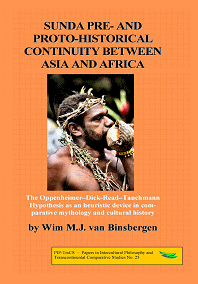
|
Now
published: During most of
2020, when the whole world was in the clutches of
the COVID-19 scare, Wim van Binsbergen mainly
worked on the completion of his new book, which
was effectively published Fall 2020: :
Wim M.J. van Binsbergen, 2020, Sunda
Pre- and Proto-Historical Continuity between
Asia and Africa: The
Oppenheimer–Dick-Read–Tauchmann
hypothesis as an heuristic device in
comparative mythology and cultural history,
with special emphasis on the Nkoya people of
Zambia, Africa, Hoofddorp: Shikanda Press,
Papers in Intercultural Philosophy /
Transcontinental Comparative Studies, 632 pp,
120 illustrations, 45 tables, indexes of
authors and of proper names, ISBN
978-90-78382-39-3, retail price EUR 90. (click
on this hyperlink for free access to the
book's PDF)
FROM THE AUTHOR'S INTRODUCTION:
| ‘...Is this
then what this massive, belated book is
all about: settling old scores? I
hardly think so. It is about redressing a
mild injustice I have inflicted upon
Stephen Oppenheimer, back in 2007, for
dismissing too quickly and on too narrow
grounds his surprisingly illuminating
idea of Sunda impact on Western Eurasia.
It is about the strengths and weaknesses
of a network perspective on the world
that is truly globalised in the sense
that it seeks to be not only world-wide,
but also free from the suffocating
limitations of hegemonic Eurocentrism and
racialism. It is about the aesthetic and
existential thrills of developing and
applying a coherent world picture that
encompasses vast reaches in space and
time, and that takes into account
humankind’s articulation of the
challenges and rewards of existence in
recognisable stories that never cease to
capture and move us. It is about the
glories and fulfilments of (at least my
personal ideal of) sustained,
painstaking, well-informed, responsible
yet imaginative scholarship in our
digital age, where disciplinary
boundaries dissolve under the onslaught
of the digitalisation of libraries, but
the dangers of amateurish blunders
increase exponentially – as no
expert reader of this book can fail to
notice. And it is,
finally, an experiment in the application
of a terrifying finding that came out of
another one of my current writing
projects, Sangoma Science:
contrary to naïve common belief, the
past is not necessarily fixed once for
all; it is malleable and in flux, both in
the hands of historians and in actual,
material fact; so that formulating a new
vision of humankind’s
transcontinental past, may project itself
back into time, and actually, materially,
change the past accordingly – change
the course of history! This has been,
after all, the deepest inspiration of my
life-long struggle to make history where
before there was none.
Having regrettably
spend too large a portion of my dwindling
allotted time on pummelling this cursed
book into more or less presentable state,
I am less sure than ever that Sunda is
actually such a good idea [ – but it
led to serendipities (especially the idea
of a global maritime network emerging
since the Bronze Age) that seem a better
idea. ] And it will worm itself back in
time, and reshape the course of history
so as to install, for better or worse,
our Phantom Voyagers (Dick-Read)
to their proper role as powerful
correctives of Eurocentric racialist
delusions of grandeur.’
|
|
|
|
| August 2020 |
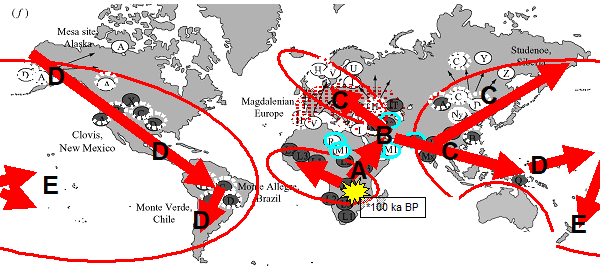 |
The analysis of global distributions of
ethnographic and mythological traits is at the
heart of Wim van Binsbergen's approach to the
challenges of transcontinental continuities since
the Palaeolithic. Not always are the
distributions straight-forward and not always are
they interpretable with the Sunda Hypothesis of
Oppenheimer--Dick-Read--Tauchmann. The following
analysis (the PDF of a PowerPoint presentation)
looks at Graebner's (1909) global distributional
data on the so-called Melanesian Bow, which turns
out to be not at all originally Melanesian, but
sub-Saharan African, c. 100 ka BP: Due to
pressure of time, this draft paper is still in
telegram syle and in a mixture of English and
Dutch, but the diagrams and the conclusion are
accessible to the English-language reader Now uploaded:
van Binsbergen, Wim
M.J., 2020, ‘Graebner-based analysis
Melanesian bow'; at: http://www.quest-journal.net/shikanda/topicalities/graebner_bow_2020.pdf
|
|
| |
|
|

|
not all more or less ephermeral papers by Wim
van Binsbergen made it to inclusion in the
present website. Some are only now retrieved and
made available. The following link shows that the
global history of transcendence was already on
the author's mind when on a lecturing tour in
Cameroon in 2005: Now uploaded:
van Binsbergen, Wim M.J., 2005, ‘The
idea of transcendence as a factor in African
agency today’, summary of a public
lecture, University of Buea, South-West
Region, Cameroon; at: http://www.quest-journal.net/shikanda/publications/binsbergen_transcendence_seminar_Buea_2005.pdf
|
|
| |
|
|
 |
Finalising his major book on the Sunda
Hypothesis in relation to sub-Saharan Africa (now
in the press), Wim van Binsbergen has tried to
fill several of the outstanding lacunae by
writing distributional analyses of globally
distributed mythemes that apparently produce
East-West parallels possibly amenable to
interpretation in terms of
Oppenheimer--Dick-Read--Trautmann's Sunda
Hypothesis. These detailed analyses proved too
lengthy to be accommodated in the Sunda book
itself: 1)
Now uploaded:
van Binsbergen, Wim
M.J., 2020, The Cosmic Egg in global cultural
history: A revised distributional exercise in
comparative mythology, at: http://www.quest-journal.net/shikanda/topicalities/CHAPTER_COSMIC_EGG.pdf
2) Now
uploaded:
van Binsbergen, Wim
M.J., 2020, The
leg child in global cultural history: A
distributional exercise in comparative
mythology, at: http://www.quest-journal.net/shikanda/topicalities/leg_child.pdf
3) Now
uploaded:
van Binsbergen, Wim
M.J., 2020, The ogre in global cultural
history: A distributional exercise in
comparative mythology, at: http://www.quest-journal.net/shikanda/topicalities/OGRE_CHAPTER.pdf
|
|
| |
|
|
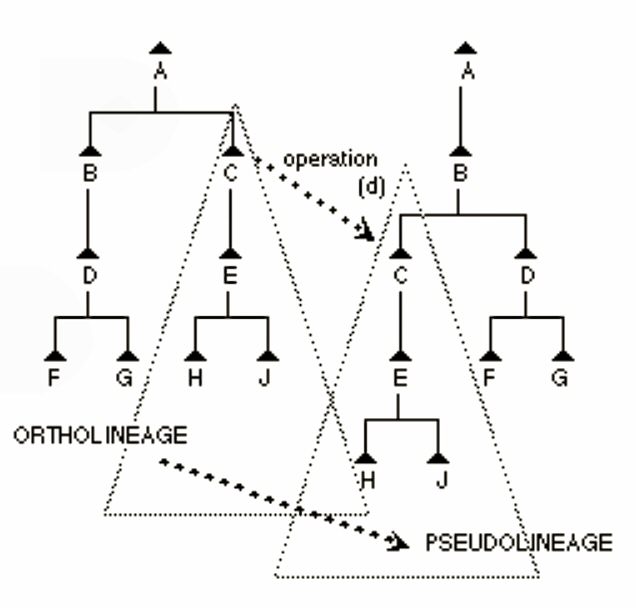 |
In preparation of the final publication of
his two-volume monograph on popular Islam in the
highlands of North-Western Tunisia, 1750-1979 CE,
Wim van Binsbergen found that an essential set of
data underlying the qualitative and quantitative
analyses in that book, for technical reasons
(typographical / phiotographic imperfectons),
cannot be accommodated within the pages of that
book itself: an exhaustive reconstruction of the
genealogies, going back to c. 1750 CE, of all
1968 inhabitants of the research area, ca. 12 km2
and encompassing the valley of Sid Mhammad, as
well as parts of the valleys of al-Mazuz,
Saydiyya, homdat Atatfa, 'Ain Draham; as ell as a
few bordering homdats such as Khadayriyya, and
Homran. In ways to be set out in full detail in
the forthcoming book, the reconstruction (which
involves the redress of many distortions,
omissions and the negotiation of delicate
local-level politics) is based on several dozens
of in-depth formal interviews (conducted in 1968,
with the competent and untiring field assistance
of Mr Hasnaûwi bin T.ahar), with all living
adults concerned, as well as hundreds of more
informal scraps of genealogical information
volunteered, and collected in passing, during the
fieldwork of 1968 and 1970. The full data set was
instead photographed and uploaded as follows: Now uploaded:
van Binsbergen, Wim
M.J., 1969 / 2020, 'Complete genealogies
(reconstructed) for the inhabitants (1968) of
the villages of Sidi Mhammad and Mayziya,
homdat 'Atatfa, 'Ain Draham, Tunisia', at: http://www.quest-journal.net/shikanda/Berber/genealogy_comprim_trim.pdf
|
|
|
| June-July 2020 |
|
| April - May 2020 |
| source:
https://beeldbankwo2.nl/nl/beelden/detail/
9f18f9ae-025a-11e7-904b-d89d6717b464 details
given there:
| Michiel
Dirk Jan van Binsbergen. No. 1586.
Geboorteplaats: Amsterdam Geboortedatum:
04-05-1912 Plaats van overlijden: Hamburg
Datum van overlijden: 03-05-1945 Beroep:
huisschilder Groep: verzet
''Mercatorstraat 139, Amsterdam.''
''Werkte voor de CPN in het normale
politieke illegale werk.'' |
|
This month it is 75 years ago
that Wim van Binsbergen's father's brother, Chiel (Michiel)
van Binsbergen (born 1912,
- whose father Henk had died a mobilised
Netherlands soldier during the Spanish
Influenza pandemic of 1918,
- who like his siblings grew up in the
Amsterdam popular neighbourhood Jordaan,
- a house-painter by trade -- like Hitler
himself! --,
- and the leader of the Amsterdam Communist
anti-Nazi resistance cell 'Mercatorstraat
139',
after four years of imprisonment was killed in
Hamburg, Germany, a few days before the end of
World War II. It is unclear whether Chiel was
deliberately executed when the Third Reich
collapsed, or found his death by misadventure
when a German ship transporting prisoners was
bombed by the Allied Forces in the Hamburg
harbour. In honour of his heroic uncle, Wim often
identifies as Michiel -- his second given name
anyway, which he received at birth one and a half
years after his uncle's death. In his scientific
work, geared to liberation (especially of Africa
in a global context) and intercultural
understanding, and with an explicit Marxist
orientation, Wim has kept this heroic inspiration
alive. This has also enabled him to identify
with, and learn essential political lessons from,
the freedom fighters and freedom thinkers that
crossed his path later in life, such as Jean-Paul
Sartre, Erich Fromm, Wim Wertheim, Karl Marx,
Friedrich Engels, Ray Alexander, Jack Simons,
Klaas de Jonge, Jaap van Velsen, Martin Gardiner
Bernal, and Valentin Mudimbe. Those who have
known Wim will realise how closely his
intransigent personality has remained loyal to
his family background and its causes.
- van Binsbergen, Wim M.J.,
1981, Religious Change in Zambia:
Exploratory studies, Londen /
Boston: Kegan Paul International; also as
Google Book
- van Binsbergen, Wim M.J.,
& Geschiere, Peter L., 1982, Oude
produktiewijzen en binnendringend
kapitalisme: Antropologische verkenningen
in Afrika, Amsterdam: Vrije
Universiteit.
- van Binsbergen, Wim M.J.,
& Peter L. Geschiere, 1985, eds, Old
Modes of Production and Capitalist
Encroachment, London / Boston: Kegan
Paul International.
- van Binsbergen, Wim M.J.,
1997a ed., Black Athena: Ten Years
After, Hoofddorp: Dutch
Archaeological and Historical Society,
special issue, Talanta: Proceedings of
the Dutch Archaeological and Historical
Society, vols. 28-29, 1996-97; updated
and expanded version: van Binsbergen, Wim
M.J., 2011, ed., Black Athena comes
of age: Towards a constructive
re-assessment, Berlin / Boston /
Munster: LIT; also at: http://www.quest-journal.net/shikanda/topicalities/20102011.htm under ‘August 2011’
and on a special Black Athena website: http://www.quest-journal.net/shikanda/afrocentrism/index.htm
- Konings, P., van
Binsbergen, Wim M.J., & Hesseling,
G.S.C.M., 2000, eds., Trajectoires de
libération en Afrique contemporaine,
Paris: Karthala; also as Google Book
- van Binsbergen, Wim M.J.,
2001b, ‘Ubuntu and the globalisation
of Southern African thought and
society’, in: Boele van Hensbroek,
P., ed., African Renaissance and
ubuntu philosophy, special issue of:
Quest: An African Journal of
Philosophy, 15, 1-2: 53-89; revised
reprint in van Binsbergen 2003b: 427-458;
also at: http://www.quest-journal.net/shikanda/ntercultural_encounters/index.htm
- van Binsbergen, Wim M.J.,
2003, Intercultural encounters:
African and anthropological towards a
philosophy of interculturality,
Berlin / Boston / Muenster: LIT; also at:
http://quest-journal.net/shikanda/intercultural_encounters/index.htm , espec. http://quest-journal.net/shikanda/intercultural_encounters/Intercultural_encounters_FINALDEFDEF9.pdf
- van Binsbergen, Wim M.J.,
2004, Postscript: Aristotle in Africa
– Towards a Comparative Africanist
reading of the South African Truth and
Reconciliation Commission’, in:
Philippe-Joseph Salazar, Sanya Osha, Wim
van Binsbergen , eds., Truth in
Politics, Rhetorical Approaches to
Democratic Deliberation in Africa and
beyond, special issue: Quest: An
African Journal of Philosophy, XVI,
pp. 238-272; also at: http://www.quest-journal.net/2002.htm
- van Binsbergen, Wim M.J.,
2005, ‘ ‘‘An
incomprehensible miracle’’
– Central African clerical
intellectualism versus African historic
religion: A close reading of Valentin
Mudimbe’s Tales of Faith’, in:
Kai Kresse, ed., Reading Mudimbe,
special issue of the Journal of
African Cultural Studies, 17, 1,
June 2005: 11-65; also at: http://www.quest-journal.net/shikanda/publications/ASC-1239806-193.pdf ; reprinted in van Binsbergen
2015: Chapter 12.
- van Binsbergen, Wim M.J.,
2012a, ‘Production, class formation,
and the penetration of capitalism in the
Kaoma rural district, Zambia,
1800-1978’, in: Panella, Cristiana,
ed., Lives in motion, indeed.
Interdisciplinary perspectives on social
change in honour of Danielle de Lame,
Series ‘Studies in Social Sciences
and Humanities’, 174. Tervuren:
Royal Museum for Central Africa, pp.
223-272; also at: http://www.quest-journal.net/shikanda/topicalities/class_formation.pdf
- van Binsbergen, Wim M.J.,
2015, Vicarious reflections: African
explorations in empirically-grounded
intercultural philosophy, Haarlem:
PIP-TraCS - Papers in Intercultural
Philosophy and Transcontinental
Comparative Studies - No. 17, also at: http://www.quest-journal.net/shikanda/topicalities/vicarious/vicariou.htm
|
|
| |
|
|
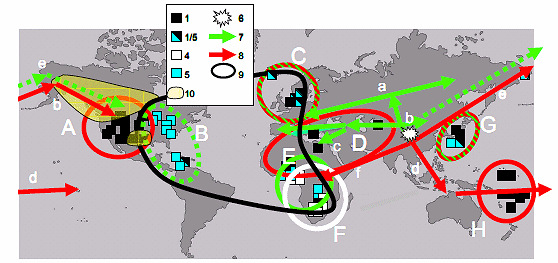 |
Seeking to complete his major book on the
Sunda Hypothesis in relation to sub-Saharan
Africa, Wim van Binsbergen has tried to fill one
of the outstanding lacunae by writing an analysis
of spider mythology world-wide: Now uploaded:
van Binsbergen, Wim M.J., 2020,
Spider mythology world-wide as a window on
possible Sunda effects resulting in East-West
parallels
|
|
| |
|
|
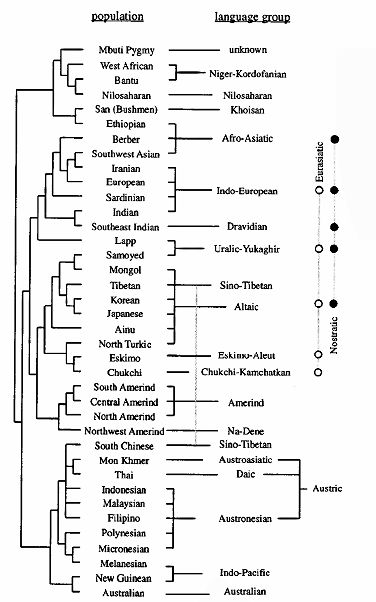 |
 |
| << illustration in this
article |
Now published:
van Binsbergen, Wim M.J., 2020, 'Notes
on the fundamental unity of humankind', special
issue on 'African thought and dialogue' , guest
editor Felix Olatunji, Culture and Dialogue,
8, 1: 23-42
|
|
| |
|
|
 The
leading elder 'Amer bin Mabruk at the village of
Hamraya, ' Atatfa, Janduba,
Tunisia 1968: a local exponent of wisdom
|
Now published: van
Binsbergen, Wim M.J. 2020, ' Grappling with the
ineffable in three African situations: An
ethnographic approach' , in: Kao, P.Y., &
Alter, J.S., eds, Capturing the ineffable: An
anthropology of wisdom, Toronto / Buffalo:
University of Toronto Press, pp. 179-242; click here for a prepublication copy
|
|
| |
|
|
 |
Now uploaded: van Binsbergen, Wim M.J., 2020, 'The
case of kings as Tears of Rain (Nkoya, Zambia) /
humankind as Tears of Re' (Ancient Egypt) : A
test-case of African / Egyptian continuity in
myth, prepublication copy', at:
http://www.quest-journal.net/shikanda/topicalities/tears_of_ra
_from_2008_ravenstein_paper_BEST_2020.pdf , 18 pp.
being an extensive, extensively edited,
Egyptological excerpt from a paper which Wim van
Binsbergen delivered at the 2nd Annuam Meeting of
the International Association of Comparative
Mythology, Ravenstein, The Netherlands, 2008;
without the Egyptological content, the revised
paper was subsequently published as: van
Binsbergen, Wim M.J., 2010c, 'The continuity of
African and Eurasian mythologies: General
theoretical models, and detailed comparative
discussion of the case of Nkoya mythology from
Zambia, South Central Africa', in: van
Binsbergen, Wim M.J., & Venbrux, Eric , eds.
New Perspectives on Myth: Proceedings of the
Second Annual Conference of the International
Association for Comparative Mythology, Ravenstein
(the Netherlands), 19-21 August, 2008,
Haarlem: Papers in Intercultural Philosophy and
Transcontinental Comparative Studies, pp.
143-225, also at: http://www.quest-journal.net/PIP/New_Perspectives_On_Myth_2010/New_Perspectives_on_Myth_Chapter9.pdf
|
|
| |
|
|
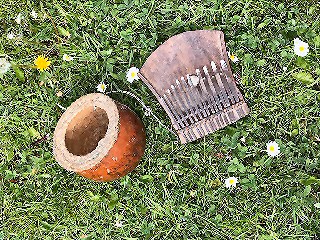 |
Seeking to complete his major book on the
Sunda Hypothesis in relation to sub-Saharan
Africa, Wim van Binsbergen tried to fill one of
the outstanding lacunae by writing a short,
lavishly illustrated and referenced piece, based
on a distributional analysis of musical
instruments worldwide:
van Binsbergen, Wim M.J., 2020,
'Identifying possible Sunda influence on
selected musical instruments in use among the
Nkoya people of Zambia in the 20th c. CE'
(click for PDF) . 14
pp.
towards the end of this paper,
links are given to sample videos of Nkoya music
|
|
|
| March 2020 |
|
| January-February 2020 |
|
|
Only in mid-February 2020, nearly two weeks
after the event, Wim van Binsbergen (residing in
the Netherlands, recently moved to a new address,
and frequently travelling to Africa and Asia)
received word of the death, on 3rd February 2020,
of his friend and colleague Renaat Devisch,
founder-leader of the Louvain School of
Anthropology in Belgium, main ethnographer of the
Yaka (Congo), psychoanalist, and a principal
exponent of the anthropology of symbol and
symptom (medical anthropology), divination,
sorcery, decolonisation, etc. Renaat's and Wim's
acquaintance dated from the 1979 Leiden
Conference on Theoretical Explorations in African
Religion, which was convened, and
subsequently published (1985), by Matthew
Schoffeleers and Wim van Binsbergen -- and which
contained Renaat's splendid overview of African
divination. From 1985 Renaat and Wim have closely
and frequently collaborated in research (over the
years Wim was a frequent speakers at Renaat's
research seminars), publishing, teaching
(co-examining nearly a dozen PhDs) and academic
administration especially in the Belgian context
of the Louvain (Leuven) Faculty of Social
Sciences, and the National Science Foundation /
Fonds voor Wetenschappelijk Onderzoek FWO. Renaat
commented on Wim's pathbreaking book Intercultural
Encounters and documented
Wim's sangoma divinatory practice in the New
Encyclopedia of Africa. Wim frequently wrote
on the Louvain School and its method (e.g. in the
journal Medical
Anthropology, 1992), and reflected on
Renaat's approach to urban churches in Kinshasa,
Congo, as a case of virtuality (e.g, 2015: 136
f.). Wim was also one of the contributors to the
2011 book edited by Renaat and Francis Nyamnjoh,
The
postcolonial turn: Re-imagining anthropology and
Africa, which was triggered by Renaat's
receiving a honoroary doctorate from the
University of Kinshasa, Democratic Republic of
Congo -- Renaat's life-long fieldwork context.
Also when unbearable illness and personal
misfortune weighed heavily down on Renaat, Wim
intensively assisted him in the publication of
his last few books, one
of which was prefaced by Wim. In Renaat
Devisch, Europe has lost one of the most
significant, sophisticated, profound and
innovative anthropologists of our time.
Regrettably having been unable to publicly pay
his respects in the context of Renaat's funeral,
Wim is now drafting a personal obituary of his
friend, to be added to this website shortly. |
|
| |
|
|
| |
At the request of the journal Culture and
Dialogue, Wim van Binsbergen (member of the
advisory editorial board of that journal) wrote a
piece
van Binsbergen, Wim M.J., in press (2020),
'Notes on the fundamental unity of
humankind', special issue on African
Philosophy, Culture and Dialogue, 7, 2.
which
is to by published shortly; click for a preview
(PDF)
|
|
| |
|
|
| |
After his extensive work on wisdom in
2007-2009, Wim van Binsbergen's innovative
revisiting of the topic of wisdom
van Binsbergen, Wim M.J., ‘Grappling
with the ineffable in three African
situations: An ethnographic approach’,
ter perse in: J. Alter and P. Kao, The
ineffable captured: Wisdom, Toronto: Toronto
University Press, prepublication copy at:
http://quest-journal.net/shikanda/topicalities/wisdom
paper wim rewritten 2017 defdef.pdf
is to be published this 2020 Spring.
|
|
| |
|
|
 |
During most of January 2020 Wim and Patricia
van Binsbergen travelled in and around the city
of Chiang Mai in Northern Thailand. Click the
following link for an extensive pictorial and
analytical account of salient observations and
experiences, especially in the field of Theravada
Buddhism and its local expressions: http://www.quest-journal.net/shikanda/thaiproef/thai_hyperlink.htm
The image to the left depicts a splendid
Buddha from the collection of the Wat Prah That
Hariphunchai temple in the town of Lamphun, near
Chiang Mai
|
|
|
| 2020 |
begins above this beam |
| August-December 2019 |
 |
Late December 2019 saw the final publication
of:
van
Binsbergen, Wim M.J., 2019, ed., Rethinking
Africa's transcontinental continuities:
Proceedings of the Leiden 2012 International
Conference, special issue, Quest: An African
Journal of Philosophy / Revue Africaine de
Philosophie, vols 26-28, 460 pp.
|
|
| |
|
|
 |
The Fall of 2019 saw the provisional
publication of the first final version of
van Binsbergen, Wim M.J., in press, Joseph
Karst: As pioneer of long-range approaches to
Mediterranean Bronze Age ethnicity (Sea
Peoples and Table of Nations), Hoofddorp:
Papers in Intercultural Philosophy and
Transcontinental Comparative Studies.
Being an updated by-product of the enormous
work Wim van Binsbergen and the Ancient Historian
/ Luwologist Fred Woudhuizen put into their 2011
magnum opus: van Binsbergen, Wim M.J., &
Woudhuizen, Fred, C., 2011, Ethnicity in
Mediterranean Protohistory, British
Archaeological Reports (BAR) International Series
No. 2256, Oxford: Archaeopress, also at: http://www.quest-journal.net/shikanda/topicalities/Ethnicity_MeditProto_ENDVERSION%20def%20LOW%20DPI.pdf
, Wim van Binsbergen was particularly fortunate
in enlisting the critical feedback from Fred
Woudhuizen for this provisional version of the
Karst book -- resulting in many major and minor
improvements which will greatly enhance the
relevance of the final version; the latter is to
be expected in the first half of 2020
|
|
| |
|
|
| |
At the request of the Department of
Philosophy, Groningen University (Dr Pieter Boele
van Hensbroek), Wim van Binsbergen undertook to
organise and supervise an internship in
intercultural philosophy by the advanced BA
student Ms Femke Vulto. The focus was agreed to
be on the so-called Ontological Turn in
Anthropology (scarcely a confidence-inspiring
term -- after the Linguistic, the Metaphysical,
Postcolonial, etc. 'turns' of the second half of
the 20th c., and the -- no longer so --
fashionable sell-out of the social sciences to
ill-digested French post-structuralism, cf. Wim
van Binsbergen's devastating criticism in his Vicarious
Reflections (2015), pp. 44 f.). Ms Vulto
concentrated on the work of the South American
anthropologist Eduardo Viveiros de Castro, who is
a proclaimed adept of the Ontological-Turn
movement. In the course of her internship, under
the intensive and radical feedback from Wim van
Binsbergen, her assessment of Vivieros' work
became increasingly critical, and her
understanding of interculturality grew
commensurately. Unfortunately, we are not at
liberty to offer access here to the splendid
final essay she wrote in collaboration with her
supervisor. |
|
|
| July 2019 |
| Barely returned
from Japan, Patricia and Wim van Binsbergen
performed at the 60th birthday of Antje de Wit,
prominent choir director and singing pedagogue.
Rising to the occasion, Wim had written three
haikus (on TIME, SPRING and MUSIC) which Patricia
interpreted inimitably both vocally and on an
improvising instrument, the lip drum. [ click here for the haikus, in
Dutch ] |
|
| |
|
|
While copy-editorial work
continues on the proceedings (460 pp) of the 2012
valedictory conference which the African Studies
Centre, Leiden, offered to Wim van Binsbergen on
the occasion of his formal retirement, he
vacillates between several other projects
hopefully to be completed this year:
- a long-standing book project entitled The
leopard's unchanging spots (on
leopard-skin / granulation / speckledness
symbolism worldwide and, across the ages,
even all the way back to the Middle
Palaeolithic);
- Our drums are always on my mind: Nkoya
history, culture and society;
- Testing the Sunda hypothesis: Provisional
report on the proto-historical
transcontinental connections of the
Bamileke people of Cameroon; and
- Aspects of Africa's Sunda connections.
|
| |
|
|
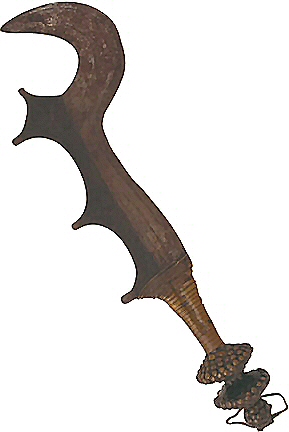 |
Shikanda Press (http://www.quest-journal.net/shikanda/PRESS
) started out on a small, informal scale in
2004 as a context for the publication of Quest:
An African Journal of Philosophy / Revue
Africaine de Fphilosophie, whose Editor-in-Chief
Wim van Binsbergen has been since 2002 -- taking
over from Pieter Boele van Hensbroek (the
founding editor together with Ron Bwalya).
Gradually also the management of the huge Quest
website (http://www.quest-journal.net),
and the publication of some of Wim's books of
poetry, were to be accommodated under the
Shikanda Press umbrella. Apart from Quest, the
first major book publication was New
Perspectives on Myth, -- the proceedings
(edited by Wim van Binsbergen and Eric Venrbux,
the conference conveners) of the2008 Second
Annual Conference of the International
Association for Comparative Mythology. Meanwhile
the seminal series PIP-TraCS (Papers in
Intercultural Philosophy / Transcontinental
Comparative Studies) was launched, in which
already several dozen titles have appeared,
associated with the names of such scholars as
Vincent Shen, Sanya Osha, Fred Woudhuizen, Pius
Mosima, and Wim van Binsbergen. The next obvious
step is the formalisation and standardisation of
the distribution of the books, by launching, as
per 1st August 2019, Uitgeverij Shikanda Press as
a fully-fledged registered company, and having
its books distributed by the leading Netherlands
book-distribution agency Centraal Boekhuis
(Culemborg), which ensures their availability in
bookshops both throughout the Netherlands and
worldwide. |
|
|
| January-June 2019 |
 |
Now published:
Wim M. J. van Binsbergen, 2019, De
Eikan-do tempel: Fotografische en poetische
reisimpressie rond een minder bekende tempel
in Kyoto, Japan, Hoofddorp: Shikanda: ISBN
978-90-78382-43-0, 93 pp. [ with 10 new poems
and dozens of full-colour photographs ],
EUR30.00. [ click here
for free access to the fullcolour PDF and
to the
fullcolour cover ] :
|
| |
|
|
 |
WEDDING AND ANNUAL FESTIVAL. The
last weekend of June 2019 saw the wedding of
Hannah (at age 25 already a celebrated poet, and
the youngest daughter of Patricia and Wim van
Binsbergen) with the Italian-born political
philosopher Enzo Rossi. At the same time,
Kazanga, the annual festival of the Nkoya people,
was celebrated in Kaoma district, Zambia, on
which Wim has published at length over the
decades. Unable to attend this year, Wim had to
make a firm promise to participate next year.
Many other important items could be added to the
chronicle here, involving all members of our
family -- but this must wait till I have
approached them out for formal permission to do
so. |
| |
|
|
 A Shinto shrine
|
TRIP TO JAPAN. From mid-April till mid-May
Patricia and Wim van Binsbergen made and
extensived trip to Japan. Due to the couple's
medical tribulations over the past years, an
important purpose of this trip was to find out
whether such intercontinental travel was still
within their reach. The results were immensely
gratifying, thanks to the elaborate preparations
but also thanks to the charms and excellent
infrastructure of present-day Japan. The round
trip took them to Kagoshima (the southernmost
city of the isle of Kyushu), Yoron (a subtropical
island far south into the Chinese Sea), Kumamoto,
Nagasaki, Kyoto and Nara. A selection of
photographs will be uploaded soon. On the basis
of interest kindled during Wim's earlier visits
to Japan (2005, 2009), a large number of temples,
shrines, formal gardens, and museums was visited
and photographed during this recent trip. In
Kyoto and Nara the coupled stayed in their own
rented city apartments, exploring the city on
foot and by public transport. In Kyoto Wim
renewed his acquaintance with the University's
Graduate School of African Regional Studies. Here
he gave a well-attended seminar on 'The African
State: retrospect and prospect' (click for abstract),
and -- as guest this time of Prof. Akira Tanaka,
San specialist) revived the intellectual contacts
he had established in 2005 around the School's
impressive research on South Central and Southern
Africa. Occuring at a time when Wim's interest in
religious and philosophical studies had yielded
several major books within a few years (Vicarious
reflections, 2015; Religion
as a social construct, 2017; Confronting
the Sacred: Durkheim vindicated, 2018), new
projects have been inspired by this trip --
including one on minor road-side shrines in the
present-day Japanese urban environment, and one
(already completed, see above) on the magnificent
Eikan-do temple in East Kyoto. |
 spring in Kyoto, with Patricia
van Binsbergen
|
|
| 2019 |
begins above this beam |
| November-December 2018 |
 |
SARAH VAN
BINSBERGEN obtained a BA in anthropology
from Amsterdam University (like her
father before her) and an MA in
anthropology and cultural politics from
Goldsmith College, London, UK. She is the
editor-in-chief of the online art journal
HardHoofd, and editor with the Valiz
publishing house specialising in modern
art, and its criticism / philosophy. With
her essay 'Een camouflagepak van
kippengaas' (chickenwire as a camouflage
combat dress) she was runner-up in the
category ESSAYS in the 6th biannual
national Prize for Young Art Criticism,
2018. Included in the Dutch-language
competition book of the same title, her
prize-winning essay will be translated
into English and published on the
competition website
photo (c) 2018 Aad Hoogendoorn |
|
 |
| |
|
|
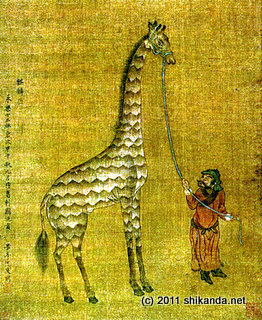 |
In 2012 Wim van Binsbergen retired from the
African Studies Centre Leiden (ASCL). On this
occasion an international valedictory conference
was organised under the title RETHINKING AFRICA'S
TRANSCONTINENTAL CONTINUITIES IN PRE- AND
PROTOHISTORY. Despite setbacks in the publication
process largely due to Wim van Binsbergen's (the
convenor's and editor's) ill health, the editing
was finally completed and the final manuscript
(18 chapters, 450 pp) submitted to the
publisher's. In the title of the edited version
of this collection, the words 'pre- and
protohistory' have been omitted: history,
anthropology, and philosophy rather than
archaeology dominate its contents. All
contributors (a truly transcontinental lot),
conference organisers and the ASCL as main
initiator and funding agency, are warmly thanked
for their patience and continuing support of this
path-breaking undertaking, which may considerably
change the accepted perception of Africa and
Africans. |
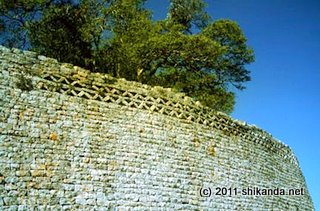 |
|
| September-October 2018 |
Now published: the Festschrift for
the 70th birthday of Wim van Binsbergen,
 |
On the occasion of Wim van Binsbergen
70th birthday (25-2-2017), a number of
friends, colleagues and former students
prepared a Festschrift entitled:
Mosima,
Pius, 2018, ed., A transcontinental
career: Essays in honour of Wim van
Binsbergen, Hoofddorp: Shikanda
Press, 309 pp, ISBN 978-90-78382-35-5
(to be distributed by Amazon.com and
by Centraal Boekhuis, Nederland), EUR
39.00
click on the hyperlink above, or
on the cover, for free access to the
book's table of contents (also list
of contributors), and fulltext PDFs
of the chapters
The cover photograph
shows Wim van Binsbergen / Tatashikanda
(left) with his adoptive cousin Dr
Stanford Mayowe (right), kneeling and
clapping the royal salute in the setting
sun, so as to gain entry to the royal
capital of King Mwene Kahare (the
former's adoptive father / the latter's
uncle) of the Mashasha Nkoya people,
Western Zambia, 1992. Note the pointed
poles supporting the reed fence -- a
jealously guarded royal privilege in this
part of the world, and one in which Sunda
influences resonate.
the book's frontispiece:
Wim van Binsbergen in his study, 2017
(photo Sarah van Binsbergen)
|
|
|
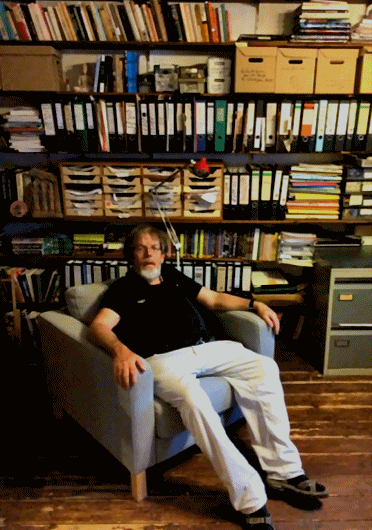 |
|
| March-August 2018 |
 |
A hundred years after his greatgrandmother
Mia, Noah Vincent Mathilde is born as the first
to open a new generation -- already prepared by
his foster cousin and by numerous adoptive and
spiritual cousins in Africa. No amount of
publishing productivity can match the sense of
fulfilment felt when contemplating one's
grandchild. |
|
| |
|
|
 |
Op 19-5-2018 was het
honderd jaar geleden dat de moeder van Wim van
Binsbergen werd geboren te Amsterdam. Voor deze
geledenheid schreef Wim een gedenkboek, dat thans
verder bewerkt wordt voor uiteindelijke
publicatie:
Wim van Binsbergen, 2018, 'Is dit mijn
kamer?' -- Het leven van mijn moeder Maria
Theodora Treuen (Mia), 1918-1984, Hoofddorp:
Shikanda, 80 pp.
|
|
| |
|
|
 |
Throughout their long careers, there has been
an intensive and fertile collaboration between
Wim van Binsbergen and the leading Belgian
anthropologist / psychoanalyse René Devisch.
Over the years, much of this collaboration has
been documented in the present website. A new
instalment is Wim van Binsbergen's Preface to
Devisch's latest book: Now published:
Wim
van Binsbergen, 2018, 'Préface', in:
Devisch, R., 2018, Corps et affects dans la
rencontre interculturelle, Louvain-la-Neuve:
Académia / L'Harmattan, pp. 17-25
|
|
| |
|
|
 |
As a second-year student in 1965, Wim van
Binsbergen was introduced to Durkheim's seminal
religion theory -- one of the most influential
approaches to religion in the social sciences.
Wim's first ethnographic fieldwork, on popular
Islam in the highlands of NW Tunisia, 1968, was
largely conceived in terms of this theory. More
than half a century later, he has finally come
round to pay his debt to Durkheim in the form of
a massive book whose writing and editing has kept
him totally occupied from February to August 2018
Now published: Wim
van Binsbergen, 2018, CONFRONTING THE SACRED:
DURKHEIM VINDICATED, Hoofddorp: Shikanda
Press, 567 pp., ISBN 978-90-78382-33-1, EUR90
(to be distributed by Amazon.com)
click
here for access to the full text via the book's
Table of Contents
click
her for the book's cover texts
click
here for a full though comprehensive summary of
the book, as is to be found in the concluding
chapter 10
|
 |
|
| January-February 2018 |
| With effective new medication,
and resuming his physical exercises which had
been discontinued in 2016 due to surgery, Wim
gradually gets back upon his feet, and begins to
face the backlog of academic contacts and
publishing projects interrupted by the removal to
Hoofddorp. With apologies to all colleagues and
friends who may have been inconvenienced by these
developments. |
| |
|
|
| Meanwhile, as pastimes, and in
order to reconstruct and test the logistic and
digital facilities once at his disposal in remote
pre-removal times, he wrote, for his sub-domain
ESSAYS, a long and appreciative critical piece on
Dan Brown's recent thriller Origin (Bantam,
2017): |

Dan Brown
|
van
Binsbergen, Wim M.J., 2018, 'An unexpected
science-fiction masterpiece: Dan Brown’s
Origin considered in the light of Teilhard de
Chardin’s work', 29 pp. (click for PDF)
|
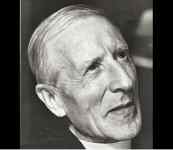
Pierre Teilhard de Chardin |
| |
|
|
| also Wim van Binsbergen completed
most of the research and writing for a further
instalment of his work on the Pelasgian
Hypothesis so warmly welcomed in Osha's piece: |

|
van Binsbergen, Wim M.J., 2018,
'Father-daughter rape and other forms of
sexual child abuse: A global distributional
exploration with special attention to the
Pelasgian Hypothesis and to Stoltenborgh's et
al.'s meta-analysis',
|
Lot and his daughters in Lucas van Leiden's
1530 depiction -- , a Biblical case of father-
daughter incest, although somewhat mitigated
by the Flood-myth parallels in the destruction
of Sodom and Gomorrah (i.e: when the entire
population is destroyed, incest may be the
only way to repopulate the world...) |
soon to be posted here when
finalised. |
| |
|
|
|
| |
2018 begins upward from here |
| November-December 2017 |
After returning from a 2-months
trip to Italy, and struggling with alarmingly declining
health, the remainder of the year was entirely taken up
with settling in the new home. It urned out that not
without punishment can one dismantle and rebuild the
entire complex infrastructure which for years had enabled
Wim (unwisely and with predictable punishment) to publish
two books a year, for over a decade. New Year's Eve ended
in near-disaster, when an ambulance had to rush Wim to a
distant hospital, where heart rhythm disorders were
diagnosed for the first time -- the symptoms had been
familiar enough for a few years, but had so far not been
picked up by the various specialists regularly consulted.
This hectic year could well have ended less hectically,
but as fireworks cascaded over the city in front of the
hospital ward's window, it became clear that the night
would not end tragically and that the unsettling events
were even a blessing in disguise: leading to diagnosis
and remedy.
|
| September-October 2017 |
| [ van de
omslag ] WIM
VAN BINSBERGEN (*1947) heeft zich
literair tot dusver vooral als
dichter gemanifesteerd; zijn
poëzie is opgenomen in de canons
van Komrij en Pfeijffer. Behalve
een recent kritisch pamflet over
W.F. Hermans (2014) verschenen
zijn eerdere literaire
prozawerken bij In de Knipscheer
(Haarlem) in de jaren 1980.
Biënnale 2023 is zijn eerste
verhalend proza in dertig jaar.
Hij heeft voorts een
wetenschappelijk oeuvre op zijn
naam staan als antropoloog,
proto-historicus, filosoof, en
vergelijkend mytholoog. De meeste
van zijn teksten zijn niet alleen
in druk beschikbaar maar ook
op:
http://www.quest-journal.net/shikanda
De
foto toont Wim van Binsbergen aan
het werk aan dit boek, te
Villammare / Sapri, Zuid-Italië,
september 2017

|
|
Nu
gepubliceerd: Nadat bijna anderhalf
jaar de BIG MOVE alle tijd en aandacht
heeft opgeëist, is het in Italie dat Wim
van Binsbergen eindelijk tijd vindt om
zijn schrijfwerk weer op te nemen. Dat
heeft al dadelijk geleid tot een nieuw
litrerair prozaboek:
Wim van Binsbergen, 2017,
Biënnale 2023 -- Scheppingsverhalen,
Haarlem: Shikanda, 128 pp, ISBN / EAN
978-90-78382-37-9; distributed on the
Internet by Amazon.com (klik hier
voor gratis toegang to de PDF van
BIËNNALE 2023)
| FLAPTEKST.
Dit is onmiskenbaar het boek van
een schrijver die zich al meer
dan een halve eeuw, als dichter,
antropoloog van de religie, en
intercultureel filosoof,
bezighoudt – maar zonder
enige vorderingen, vooralsnog -
met de diepste problemen van de
menselijke existentie. De
ontologieën die de figuren in
dit boek in de mond gelegd
worden, geven een getrouw beeld
van de aanzetten tot een
wereldbeeld waarmee de auteur
zelf worstelt – vgl. de
duistere leerdichten van
Parmenides en Empedocles. Alle
details zijn uiteraard gebaseerd
op eigen veldwerk:
Noordafrikaanse volksislam,
Zambiaanse genezingsculten,
trekarbeid vanuit Guinee-Bissau,
liefdesperikelen van de
Pakistaanse elite, genderoorlog
in het West-Azië, rechtspleging
in het land Nod, waarheidsclaims
op de Saturnus-satelliet
Callisto, voortplantingsrelaties
op het ver geëvolueerde Eiermand
en de wereld beschreven in het
verhaal ‘Buitenaardse
Liefde’. De godsbeelden zijn
gebaseerd op uitvoerige
interviews met de Betrokkene, via
divinatie en mystiek. Ook de
biografie van de plastisch
chirurg Sabatiël Eberhardt (in
‘Gietnaden’) berust op
de meest authentieke bronnen. |
|
 |
|
| |
|
|
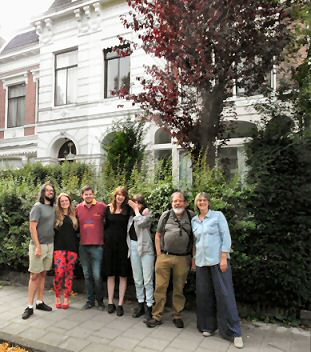
the last (somewhat selective) family photograph
taken in front of our old home |
THE BIG MOVE. The
budding Africanist (and Africa-born) Patricia
Saegerman and Wim met in Senegal in 1982.
Together they did fieldwork in Guiné-Bissau in
1983, and later that year, in preparation of
their marriage, they bought the house in Haarlem
(the provincial capital 15 kms West of Amsterdam)
where they would have and raise four children,
and would entertain numerous friends, colleagues
and students from Africa, Europe, and all over
the world. Over the years, most of Wim's literary
and academic writing was done in this house. It
also accommodated Patricia's career shift towards
activities in classical European and Indian
music, and in breathing therapy. The children
grew up, completed their studies, and went to
live in Wim's native Amsterdam. Time to finally
effect the much-needed home improvements which so
far had always failed to impose themselves as
priorities, and to trade this spacious, nearly
140 years old officer's mansion for a light,
modern alternative in a much younger town. The
children, including Nezjma (Wim's daughter from a
previous marriage) and her husband, and numerous
friends and professionals, have greatly assisted
us in disentangling us from what, after 34 years,
had become a second skin -- redecorating,
repairing and tidying, sorting out and moving the
9,000 books, the 15,000 offprints, the carloads
of fieldnotes, the musical instruments,
computers, art objects, and the memorabilia of
decades of transcontinental travelling; and
greatest problem of all, finding a temporary
solution for our two very dear cats -- which will
be just as homeless as we, in August and
September, but cannot be taken with us to Sicily.
We thank everybody for indispensible help. Having
shed this -- in retrospect, admittedly somewhat
restrictive-- skin (more than five years after
Wim was formally retired but, despite medical
problems, had continued to produce books and
doctorates at an alarming rate), we hope to
continue our, supposed, growth in freedom,
health, art, happiness, knowledge, and wisdom.
The old home was sold on 31-8, the new home will
not be available before 1-11, so we left for a
hopefully sunny and exciting very long holiday in
Southern Italy -- only to find South East Sicily
so devastatingly rainy that by comparison our
tempestuous Holland would seem to be situated in
an arid zone... click here for a generous
first selection of photographs, and
for a second selection or a
third one; the photographs are arranged by
location, but the locations are not presented in
the same order in which they were travelled.
|
 |
|
| August 2017 |
In the Spring of 2015, Wim van Binsbergen
participated in a workshop on the ineffable (that
which cannot be expressed in language) in
anthropology, convened by Joe Alter and Phil Kao,
Department of Anthropology, University of
Pittsburgh PN, USA. The conference proceedings
are now being prepared for publication by the
University of Toronto Press, and in this
connection Wim van Binsbergen has greatly revised
and expanded his original conference paper:
van
Binsbergen, Wim M.J., 2017, Grappling with
the ineffable in three African situations: An
ethnographic approach
click
here for a PDF of this final version.
|
|
|
| |
|
|
When Wim van Binsbergen, after earlier
fieldwork in North Africa and South Central
Africa, at the instigation of his long-standing
Manchester-based colleague Richard Werbner,
embarked on urban fieldwork in Francistown,
Botswana, in 1988, this turned out to constitute
a watershed in his career: from detached,
distancing anthropology of religion to active
participation in local churches and cults, in the
short term leading on to his 'becoming a sangoma'
(the title of his seminal 1991 paper in the
Journal of Religion in Africa), and in the long
term to his exchanging empirical social science
for intercultural philosophy, in the Rotterdam
chair of that designation. In the most recent
years, working on reprinting of some of his
papers in these fields, it turns out that in this
tumultuous process much of potentially lasting
value was initally cast by the wayside. The
recent collection Vicarious Reflections (2015)
revived a small book on virtually as a key to
understand especially urban situations in Africa;
while the collection Religion as a Social
Construct (2017) salvages a number of obscure or
unpublished religious-anthropological studies.
Much precious and extensive survey material both
on Lusaka churches and social control, and on
Francistown, remains to be worked into a final
publication, which will be one of the tasks for
the next few years. Meanwhile intremediate
installments become available, such as the
following two provisional overviews of a
quantitative analysis of marriage, churches and
urban social control in Lusaka in the early
1970s:
Van
Binsbergen, Wim M.J., 1987, a,
‘Urbanization, church and social
control: A survey of Lusaka, Zambia, 1973:
Summary of quantitative results — Part
1. USOCO results book II’, Leiden:
African Studies Centre, 95 pp
Van
Binsbergen, Wim M.J., 1987b,
‘Urbanization, church and social
control: A survey of Lusaka, Zambia, 1973:
Summary of quantitative results — Part
2. USOCO results book I’, Leiden:
African Studies Centre, 48 pp
These interesting provisional reports may now
be read in their original form (click the links
for PDFs). However, due to peculiarities of the
scanning process used, the original, numbered
pages appear in reversed and even rotated order.
|
|
| July 2017 |
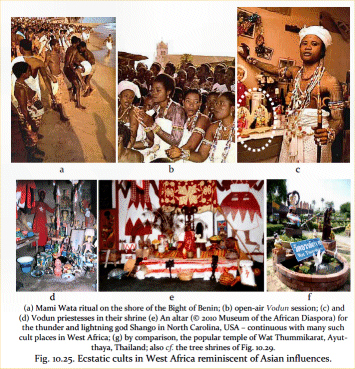
A page (p. 401) from Religion
as a Social Construct, arguing Asian/African
continuities in the field of ecstatic cults
|
despite considerable medical setbacks in the
first months of 2017, Wim van Binsbergen hoped to
renew his participation in Richard Werbner's
(ex-)Satterthwaite (UK) Colloquium on African
Religion and Ritual, with the following paper:
van Binsbergen, Wim M.J., 2017,
'Voices from afar: The African moral
imagination in transcontinental
perspective', Satterthwaite (UK)
Colloquium on African Religion and
Ritual
The paper was to reflect on Wim's recent
books, Before
the Presocratics (2012), Vicarious
Reflections (2015), and especially ch. 10 of Religion
as a Social Construct (2017); a paper
abstract is in preparation
Alas, by the time the paper had to be prepared
Wim's health went through a difficult patch, and
participation will have to be postponed till some
later year
|
|
| June 2017 |
 |
ECAS at Basel, Switserland: book
presentations In the last week of June, 2017,
the annual ECAS (European Commission for African
Studies) conference will take place in Basel,
Switzerland. Wim van Binsbergen has been a member
of the Organising Committee with special
attention to the the panels for the Philosophy
section. His participation in the actual
conference is rendered financially possible by
the joint efforts of the African Studies Centre
Leiden and the organising Basel department of
African Studies. He will participate in the
conference, and there deliver a book launch
(Friday 30 June, 12:15, location KH116; complete
with drinks and snacks) of his recent book
Vicarious Reflexctions: African explorations in
empirically-grounded intercultural philosophy. (click
for a sneak preview of the entire book)
In view of the specifics of the locality where
the book launch was to take place (a large room
with poor acoustics) a PowerPoint presentation
was prepared beforehand, so that the spoken word
was visually supported in a large screen; click
here for this
PowerPoint presentation
Also during the conference, on 29 June, the
prominent Africanist publishing house LIT Verlag
(Munster / Berlin etc.) held a book launch of
some of its recent books, and in that connection
Wim van Binsbergen was asked, without
preparation, to launch the book co-authored by
Martin Doornbos and himself, which had come off
the press a few weeks earlier: Researching
Power and Identity in African State Formation
(Pretoria: UNISA Press, see below).
Participating in this conference was a most
pleasant experience, renewing contact with dozens
of old friends and colleagues, meeting dozens of
new ones, and initiating or reinforcing various
book projects and other forms of collaboration. A
particular boon was the intellectual exchange
with the Nigerian and Mozambican scholars in the
one surviving philosophical panel, which promises
to lead to stimulating further results in the
near future.
|
 |
| |
|
| On the occasion of Wim van
Binsbergen's 65th birthday, and his official
retirement from the African Studies Centre,
Leiden (ASCL), a splendid valedictory
international conference was organised by him in
conjunction with Marieke van Winden, largely on
ASCL funding: Rethinking Africa's
transcontinental continuities in pre- and
protohistory.
The participants were drawn from four
continents and even more disciplines, and
included (among many others) Sanya Osha,
Cathérine Coquery-Vidrovitch, Oum Ndigi, Michael
Rowlands, Dierk Lange, Wouter van Beek, Li
Anshan, Cyril Hromnik, Simon Simonse, Ndu Life
Njoku, Robert Thornton, Alain Anselin, Vaclav
Blazek (in the book Zuzana Malashkova will appear
as co-author), Robert Dick-Read, Yuri Berezkin,
Christopher Ehret, and Pieter Boele van
Hensbroek. Preparation of the proceedings under
the editorship of Wim van Binsbergen was delayed
by the state of retirement (which the conference
was to celebrate in the first place), several
spells of very serious illness, the need to give
priority to other projects, and lack of all
institutional editorial / secretarial support for
this publication project. Yet meanwhile a draft
manuscript has been prepared and provisionally
formatted and edited; this is to go to the
publisher (designated from the beginning as
Brill, Leiden) this Summer, and after some
copy-edited to be finally published before the
end of this year. After a short Preface the book
(ca. 480 pp.) will comprise the following Parts:
- General theoretical perspectives
- Case studies
- Focus on language
- Focus on technology
Of the three papers which Wim van Binsbergen
originally contributed to the 2012 conference,
two are to be included in the book:
- one on the
Oppenheimer--Dick-Read--Tauchmann
hypothesis concerning massive South East
Asian ('Sunda' -- with an extension to
South and East|Asia) influence on Western
Eurasia and Africa in pre- and
protohistory; and the other
- his general theoretical key note,
especially exposing (now by way of
introduction) the implicit hegemonic
Eurocentrism, localism and presentism
that have been paradigmatic in
anthropology and African Studies ever
since the mid-20th century CE.
His very extensive third conference paper (on
the significance of Buddhism, Hinduism and Taoism
for Asia-Africa continuities in protohistory) has
meanwhile already been published as an oversized
chapter in his recent book Religion
as a Social Construct (2016-2017).
|
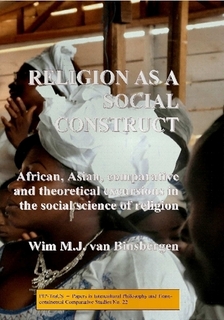 |
|
| May 2017 |
On 26 May 2017, in the northern
university town of Groningen, Wim van Binsbergen was the
key note speaker at the Annual Conference of the African
Students Community (ASC) in the Netherlands, with an
address 'Africa: Periphery or Centre of the World', which
was met with great enthousiasm by the conveners and the
audience |
| April 2017 |
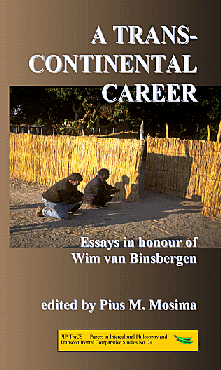 |
On the occasion of Wim van Binsbergen 70th
birthday (25-2-2017), a number of friends,
colleagues and former students prepared a
Festschrift entitled:
A transcontinental career: Essays in
honour of Wim van Binsbergen
under the editorship of Pius M. Mosima from
Cameroon. The book is now undergoing final
copy-editing, and is to appear later this year.
The cover photograph shows Wim van Binsbergen
/ Tatashikanda (left) with his adoptive cousin Dr
Stanford Mayowe (right), kneeling and clapping
the royal salute in the setting sun, so as to
gain entry to the royal capital of King Mwene
Kahare (the former's adoptive father / the
latter's uncle) of the Mashasha Nkoya people,
Western Zambia, 1992. Note the pointed poles
supporting the reed fence -- a jealously guarded
royal privilege in this part of the world, and
one in which Sunda influences resonate.
|
|
|
| March 2017 |
Now published (mid-March 2017, at long last
):
Doornbos,
M.R., & van Binsbergen, Wim M.J., 2017,
Researching Power and Identity in African
State Formation: Comparative Perspectives,
Pretoria: UNISA [ University of South Africa
] Press, 541 pp.
this extensive co-authored work, eagerly
awaited since its corrected final proofs were
submitted by the authors in Spring 2012 (!!),
critically overlooks forty years of the two
authors' complementary and contrastive research
on African states.
click
here for a fulltext PDF of the proofs
|
 |
|
| February 2017 |
| While spending six weeks travelling to and
hibernating in Southern Europe (click for
pictorial impressions of Sevilla,
Cordoba,
Cornelis
Zitman'sculpture exhibition at Cadiz,
the ancient fortress of Carcassone, and Carcassone
cathedral). (whenever you have opened
these picture pages, hit the Back button (top
left of your browser) to return to the present
page)
We had visited France numerous times before,
and Spain less frequently but still nearly a
dozen times. This time, travelling the entire
distance by car (2600 km one way) and making
substantial stops at selected major cities on the
way, reinforced our awareness of Europe as a
viable Jewish-Christian-Islamic project sustained
over two millennia. In Spain Nerja was our base
again, and our extensive explorations were
confined to Andalusia -- the ancient Vandals'
land. In Cordoba Jewry had already been silenced
or expelled for three quarters of a millennium,
so even while our visits to the famous Mesquita
cathedral led us daily through the labyrinth of
streets of the former Jewish quarter, we found
that part of the city unimpressive. The
triumphalist but destructive Christian revamping
of the splendid Islamic architecture of the
Cordoba Mesquita cathedral proved an instructive
failure. When we shared our dismay with an
another tourist, a Muslim from London, his
spirited but optimist response was 'They should
turn this place into a university where the
convergence of the three faiths would constitute
the central curriculum'. Amen to that. But the
cosmopolitan atmosphere of downtown, modern
Cordoba offered much comfort. In Sevilla's
cathedral (also visibly built on mosque remains)
the triumph of the Christian Reconquista had
reached a more advanced stage, and the result
proved less hybrid, less of a compromise, more
appallingly Baroque and complacently Christian.
The commercial Jewish museum in the former Jewish
quarter had only a small and unimpressive
collection, but reinforced our focus on the
implied Jewish understream of Western Europe --
already all but annihilated by the Christian
Inquisition half a millennium before Hitler. In
refreshingly open, bright and Atlantic Cadiz,
these ancient streams often remained totally
submerged (although also there the oldest
churches turned out to be converted mosques), and
instead the present-day testimonies commemorating
celebrated flamenco singers, guitarists and
dancers dominated the inner city. We meant to
continue and conclude our pilgrimage to Europe's
undercurrents of the three faiths with the
Cathars' Land, in the Pays d' Oc, southernmost
France -- but although the fortified ancient city
of Carcassonne (completely and scandalously
rebuilt in the late 19th c.) proved a fairy-tale
both by night and by day, the Cathars turned out
to be not only exterminated by the Inquisition
but even, recently, reduced to a touristic
selling slogan -- which left us totally
unprepared for the smashing beauty of the small
Gothic cathedral inside the ancient city.
Wim van Binsbergen reached his 70th birthday
on 25-2-2017. This was celebrated in private in
Spain, and with a massive function (organised by
Wim's wife and children and the latter's
partners) in his Haarlem home on 25-3-2017 (click here
for a photo impression); see above, for a
Festschrift to commemorate this occasion is
currently being prepared by Wim van Binsbergen's
colleagues and former students, under the
editorship of Dr Pius Mosima (Cameroon).
|
 the picture shows
Pius Mosima (facing, right)
and Wim van Binsbergen (standing left, seen at
the back)
during the seminar on Placide Tempels they
jointly delivered
at Nijmegen University, Institute for Mission
Studies, the day
after Dr Mosima obtained his PhD from Tilburg
University
(supervisors: Wim van Binsbergen & Wouter van
Beek)
|
|
| January 2017 |
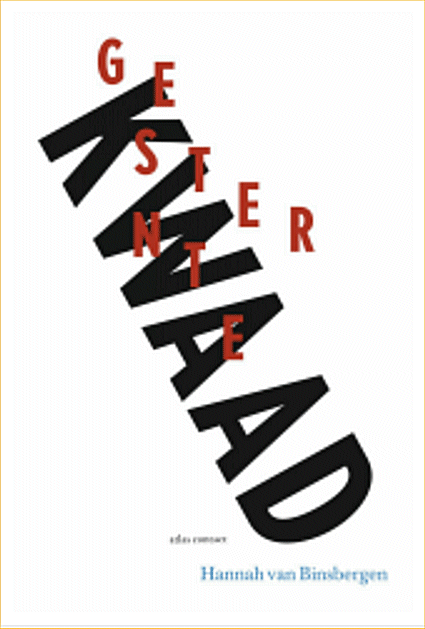 |
following in her father's footsteps as a
poet, but (despite her tender age) with rather
more concentrated focus (despite her reading
philosophy at Amsterdam University) and much more
success, Wim van Binsbergen's youngest daughter
Hannah (*1993) published her first collection of
poems entitled Kwaad
Gesternte ('Born under Evil Stars') and
immediately won the major poetry prize ('VSB') in
the Netherlands, and the national debut prize in
Belgium. |
 |
|
| 2017 begins here |
|
| December 2016 |
 |
Now published: Wim
van Binsbergen, 2017, Religion as a social
construct: African, Asian, comparative and
theoretical excursions -- a testament in the
social science of religion, Haarlem: Papers in
Intercultural Philosophy and Transceontinental
Comparative Studies, No. 22, 712 pp, 50
illustrations, 40 tables, cumulative
bibliography, Index of Authors, General Index
this book will soon be distributed by
Amazon.com. Meanwhile, for ordering this book
from Lulu as distributor, use either of the
following two buttons:
or go to the website
of Shikanda Publishing House, where book
distributors and institutions seeking a discount
may order directly from the publisher
for
Table of Contents and Indexes, and free online
access to the fulltext PDF, click here
|
| |
|
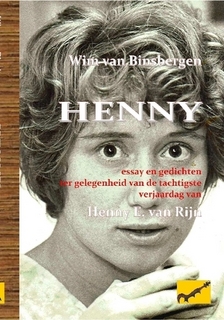 |
nu gepubliceerd maar gezien
het persoonlijk karakter voorlopig onder totaal
embargo, afhankelijk van de formele toestemming
van degeen aan wie het boek is opgedragen: Wim
van Binsbergen, 2016, Henny: Essay en gedichten
ter gelegenheid van de tachtigste verjaardag van
Henny E. van Rijn, Haarlem: Shikanda, 90 pp.
HENNY VAN RIJN, begaafd amateurmusicus, was
bijna afgestudeerd in de natuurkunde, en Wim van
Binsbergen (beginnend dichter) had juist zijn 2e
studiejaar antropologie afgesloten, toen zij
elkaar in 1966 ontmoetten. Spoedig begonnen zij
een relatie, die in 1969 leidde tot een huwelijk.
In 1971 werd hun dochter geboren. Het toverwoord
‘Afrika’ had hen samengebracht, en zij
zouden 3 jaar onder moeilijke omstandigheden in
Zambia werken (1971-1974). Maar terwijl HvR aldus
de basis hielp leggen voor WvBs internationale
carrière als o.m. antropoloog, ging haar eigen
veelbelovende carrière als onderzoeker ten
gronde aan het Afrikaanse avontuur. De 2 levens
begonnen uit elkaar te lopen, onverwerkt
kinderleed eiste zijn tol, en jarenlange liefde
en zorg van weerskanten verkeerde in het
tegendeel. Dit boekje kan daar helaas niets meer
aan goedmaken. Niettemin grijpt de auteur de
gelegenheid om een van de belangrijkste en meest
indrukwekkende mensen in zijn leven te vierenin
dankbaarheid en liefde
|
|
| June-November 2016 |
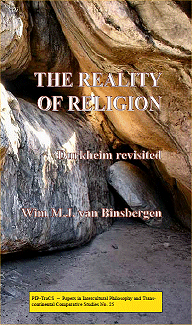 |
In the second half of 2016, Wim van
Binsbergen continued his work on various books
announced earlier, and underwent surgery. Two new
book projects presented themselves: Religion
as a Social Construct ( bringing together 16 of
his papers, 1980-2012, on the social science of
religion), and (as a by-product of the
former) The Reality of Religion: Durkheim
revisited, a newly authored book which is to
appear in the Spring of 2017. Wim van
Binsbergen served as co-organiser of the
philosophical section of the EASA Annual
Conference on African Studies ni Europe, this
time in Basel, Switzerland, mid-2017, and intends
to present a paper there
The PhD thesis defended by Wim van
Binsbergen's last PhD student Pius Mosima earlier
in 2016, was published by the African Studies
Centre, Leiden, later in 2016; the Cameroonian
photographs that embellish the cover were
explicitly attributed to Dr Mosima but were in
fact taken and supplied by his supervisor
Meanwhile Wim and Patricia van Binsbergen's
youngest daughter, Hannah, published her first
book of poetry Kwaad Gesternte, which made a
tremendous impact on the Dutch and Belgian
literary scene, and had Hannah nominated for two
of the major literary prizes in the Dutch
language region.
|
| |
|
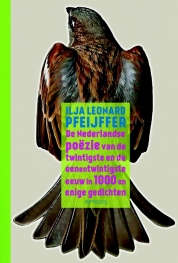 |
Wim van Binsbergen was
reeds vertegenwoordigd (met het gedicht
FRIESLAND) in Gerrit Komrij's bekende anthologie,
de canon van de Nederlandse poëzie.Tegen het
eind van 2016, verscheen een opvolger van
Komrij's bloemlezing: De Nederlandse poëzie van
de twintigste en de eenentwintigste eeuw in 1000
en enige gedichten, onder redactie van Ilja
Leonard Pfeijffer. Weer is een lang gedicht van
Wim van Binsbergen opgenomen, PIANOVERVOER. Maar
wat nog meer reden tot vreugde is: deze keer zijn
vader en dochter in dezelfde bloemlezing
opgenomen -- Hannah zelfs met drie gedichten! |
|
| April-May 2016 |
Wim van Binsbergen was a founding member of
the International Association for Comparative
Mythology (IACM) in 2006 (Beijing, China), and
has nominally been one of the Directors of this
body ever since -- although his participation has
been at a low eb since 2011. In 2016, the 10th
Annual Meeting will be held at Brno, Czech
Republic, 26-28 May. Its topic will be: Time and
Myth: The Temporal and the Eternal. Here Wim van
Binsbergen proposes to present, from notes, a
paper entitled:
'Fortunately he had stepped aside just in
time':
Mythical time, historical time and
transcontinental echoes in the mythology of
the Nkoya people of Zambia, South Central
Africa
click for
paper proposal
In 2016, the Annual Conference took place at
the Masaryk University of Brno and was
efficiently and hospitably hosted by
internationally renowned historical linguist
Vaclav Blazek with the assistance of his PhD
students. Brno is famous as the place where
genetics was founded by Fr. Mendel in the
mid-19th c. CE, but unfortunately no opportyunity
was found to visit the famous convent's botanical
garden. Deliberations by the IACM Board of
Directors led to the decision to have the 2017
Annual Meeting, once again, in Edinburgh,
Scotland, UK.
|
| |
|
| March 2016 |
| Au numéro inaugural de "Patrimoines
& Cultures", le magazine panafricain
bilingue de vulgarisation scientifique du
CERDOTOLA (Yaounde, Cameroun), Wim van Binsbergen
viens de contribuer un artice en anglais
intitulé: 'African traditions of peace-making'. |
click
here for a preview |
 A
Bamileke king with ceremonial cane (note the
orientalising face carved on it), beaded cap, and
libation horn
|
| |
|
|
| Wim van Binsbergen wrote an
extensive French preface for Rene Devisch's new
book L'extime dans la rencontre transculturelle,
now in the press |
| |
|
|
| Wim van Binsbergen accepts the
honorary position of Patron of the Cameroonian
NGO 'African Centre for Research, Innovation and
Development (ACRID)', Limbe / Buea, Cameroon |
| |
|
|
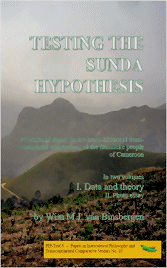 |
Now that, after almost a year of
writing and editing, the book Vicarious
Reflections has found its definitive
form and is out of the way, Wim van
Binsbergen can finally return to other
ongoing writing and editing projects. The
2012 Leiden conference Rethinking
Africa's Transcontinental continuities in
Pre-and Protohistory on the occasion of
his retirement, has reached a decisive
stage now that all relevant papers have
been submitted and the manuscript is
abnout to be submitted to the African
Studies Centdre Leiden editorial board
for one of its series with Brill
publishing house. The 2015 fieldwork on
the transcontinental continuities among
present-day Bamileke of the Cameroonian
Grassfields has meanwhile led to a
two-volume draft report Testing tdhe
Sunda Hypothesis which is now being
submitted to expert readers in Cameroon
and worldwide for finalisation. And after
the successful
special issue (volume XXV) on Masolo,
final touches are being made to the
volumes XXVI-XXVII, which are to conclude
the existence of Quest: An African
Journal of Philosophy / Revue Africaine
de Philosophie as a subscription journal
-- henceforth distribution will be in the
form of separate annual volumes through
the Internet, and through the
international channels of the book trade |
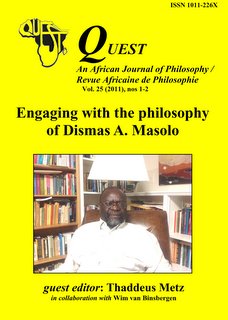 |
|
|
| Januari-Februari
2016 |

read
here the conference announcement with all
practical details
|
17 Februari 2016: Wim van Binsbergen and Pius
Mosima will be the principal speakers at a
Symposium organised by the Centre for Mission
Studies, Radboud University Nijmegen, the
Netherlands, on the Franciscan father, the
missionary Frans (clerical name Placied) Tempels
(Berlaar near Lier, Belgium, 1906 - Hasselt,
Belgium, 1977), whose seminal book
Bantoe-filosofie / Bantu Philosophy / La
philosophie bantoue, appeared in Brussels 70
years ago. The book has been recognised (though
also bitterly -- if anachronistically --
attacked) as the major catalytic influence upon
the emergence of African Philosophy as an
academic endeavour. |

|
| |
|
|
 Pius Mosima and Wim
van Binsbergen at their first meeting, Cameroon,
2005
|
16 Februari 2016: public defense, before
Tilburg University, the Netherlands (supervisors:
Profs Wim van Binsbergen & Wouter van Beek)
of the PhD thesis of Wim van Binsbergen's last
remaining PhD student, Pius Mosima; entitled:
Philosophic Sagacity and Intercultural
Philosophy: Beyond Henry Odera Oruka click here for Wim van
Binsbergen's laudatory address ('laudatio')
pronounced at the end of the public defense
|
 Pius Mosima and Wim van
Binsbergen during final supervision, in Idenau, a
fishing village at the Cameroonian-Nigerian
border, April 2015
|
|
| 2016 |
2016
begins here |
| December,
2015 |
 Now
published:
van
Binsbergen, Wim.M.J., 2015, Vicarious
Reflections: African explorations in
empirically-grounded intercultural
philosophy, Haarlem: Shikanda Press, Papers
in Intercultural Philosophy and
Transcontinental Comparative Studies, No. 17,
700 pp., numerous illustrations,
bibliography, index of authors, general index
(click for extensive webpage giving free
access to the text of this book; and details
for ordering a printed copy of this book)
|
 |
| |
|
| During this month the hosting company that
had accommmodated the http://www.shikanda.net
portal suddenly went out of business and as a
result, the website was unavailable for some
weeks. Meanwhile a temporary solution has been
created at http://www.quest-journal.net/shikanda/
, which is also owned and maintained by Shikanda
Press, notably for the purpose of Quest: A
Journal of African Philosophie / Revue Africaine
de Philosophie, and for Pip-TraCS. Time and
resources have been lacking to correct all the
external links within the temporary site, but
many links are relative and internal and these
are still working correctly. It is hoped that the
original shikanda.net site will soon be revived
under the original URL. |
|
|
| September
/ November 2015 |
during
these months work was continued on the Vicarious
Reflections book |
| August,
2015 |
| |
participation
in a Symposium at Rostock University, Fed. Rep.
Germany:
"Chaos in the Contact Zone.
Unpredictability, Improvisation and the Struggle
for Control“
August 31 - 2 September 2015
Wim
van Binsbergen, 'Identity as the performative
product of, rather than as the input into,
intercultural encounters' (click here for
abstract, PDF)
click the cover(right) to gain access to the
webpage for Wim van Binsbergen 2003 book
Intercultural Encounters, where also a link to
the PDF of the entire book may be found
This was a very useful conference, not only
because of its pleasant and sociable atmosphere
(an applecart that was somewhat upset by my own
numerous and hypercritical interventions), the
river boat ride to the nearby Baltic Sea, the
Baltic beach and the splendid Rostock Zoo, but
especially in the sense that it drove home to me,
clearer than ever before, what is wrong with the
kind of quasi-postmodern, amateur do-it-yourself
attempts at social analysis (often by people from
the humanities, history, literature science,
philosophy -- some of whom call themselves
'performing scholars') without acquaintance with,
let alone application of, the accumulated
mainstream theories and methods of the social
sciences, even when dealing with patently
social-science topics such as class formation,
ethnicity, urban situations. That lesson helped
me greatly to lend extra punch to the
introductory chapter of my new book Vicarious
Reflections, which was being finalised at the
time of the conference.
|
 click
here for a few Rostock 2015 photographs
|
|
| June /
July, 2015 |
 |
In these months Wim van Binsbergen wrote a
two-volume first draft of his report on the
Cameroonian field-work:
van Binsbergen, Wim M.J., in press,
Testing the Sunda hypothesis: Provisional
report on the proto-historical
transcontinental connections of the Bamileke
people of Cameroon: In two volumes, I. Data
and theory; II. Photo essay, Haarlem:
Shikanda Press, Papers in Intercultural
Philosophy / Transcontinental Comparative
Studies (PIP-TraCS) No. 20, ISBN / EAN:
978-90-78382-30-0 (Vol. I), 978-90-78382-31-7
(Vol. II).
Meanwhile, put off by the tedious editorial
chores attending the finalisation of his magnum
opus on forty years of Nkoya research in Zambia,
'Our Drums Are Always On My Mind', and realising
that the felicitous outcome of the new
Cameroonian field-work necessitated a thorough
revision (see entry April 2015, below) of the
models of Africa's transcontinental continuities
in pre- and protohistory which had greatly
informed the final, excessively long chapter of
that book, he decided to let work on the various
current book projects rest for a while, and to
create a break by starting on the editing of a
long-planned collection of his papers on
Intercultural Philosophy, under the title
Vicarious Reflections: African explorations in
empirically-grounded Intercultural Philosophy
-- which despite its excessive length and
complexity was completed and appeared in December
2015
|
 |
|
| May,
2015 |
| [ in May 2015 Wim and Patricia van Binsbergen
made a tour of Portugal, which however was
thwarted by very severe medical problems.
Nonetheless, the megalithic scenes around the
city of Evora, the city of Mertola as a glorious
monument of Portugal's Islamic past, the
enchanting beaches of Algarve, and selected
aspects of the capital city of Lisboa,
compensated somewhat for a most depressive
adventure |
click
here for selected miniature pictures Portugal
2015 |
| |
|
| Dennis van Binsbergen, who as youngest son
accompanied Wim van Binsbergen on his recent
Cameroonian fieldwork taking many of the crucial
photographs documenting East-, South- and
South-East Asian influences upon sub-Saharan
Africa, and who has been an important force in
the practical survival of Shikanda Press
(publisher of PIP-TraCS and Quest, and of a
literary series), took his BA in Business and
Languages at HVA Amsterdam University of Applied
Sciences in May 2015 |
 |
|
| April,
2015 |
TRANSCONTINENTAL ASPECTS OF THE
BAMILEKE PLATEAU, WESTERN GRASSFIELDS, CAMEROON.
Fieldwork on
postulated pre- and protohistoric Sunda / South
East Asian influences on the Western Grassfields,
Cameroon, during the entire month of April
2015 (this trip was originally planned for the
Autumn of 2014, see there, below -- but had to be
postponed because of the ebola aepidemic hitting
West Africa in 2014-2015). The final week of
April was spent in Buea, Anglophone Western
Cameroon, where the final supervision of the PhD
thesis of Pius Mosima was combined with
comparative explorations on the save trade at
Bimbia, and work at the rich Archives of Western
Cameroon. The trip was subsidised in part by the
African Studies Centre, Leiden, the Netherlands,
where Wim van Binsbergen is a life Honorary
Fellow, and was moreover greatly facilitated by
the loyal and multifarious assistance from Dr
Pascal Touoyem (Wim van Binsbergen's 2014 PhD),
his wife Mrs Jacqueline Touoyem née Nkouetso,
Mrs Elisabeth Kungni (the latter's sister), and
Dennis van Binsbergen, especially as assistant
and photographer. Thanks to these contributions,
an immense amount of work could be done in a very
short time, and a real break-through could be
reached in regard of models of transcontinental
continuitiy informing sub-Saharan African's pre-
and protohistory. The intuitive model hitherto
employed had an apparently solid basis in the
following points of view:
- my ongoing
ethnographic and ethnohistorical research
among the Nkoya of Zambia sinds 1972
- my ethnographic and ethnohistorical
increasingly long-range research into the
Botswana sangoma cult since 1988,
- long-range linguistic and comparative
mythological research especially in the
line of Starostin & Starostin's Tower
of Babel and the Harvard-centred revival
of comparative mythology instigated
especially by the Sanskritist Michael
Witzel
- genetic research, both the obsolescent
type highlighting classic genetic markers
(of which the Italian/American geneticist
Luigi Cavalli-Sforza has been the iconic
exponent) and, since the mid-1990s, the
far more detailed and conclusive in terms
of molecular biology
- the Oppenheimer-Tauchmann-Dick-Read
'Sunda' hypothesis of extensive South
East Asian impact on sub-Saharan Africa, as
set out by me already in 2007a
(presented at Bandung, Indonesia), and 2008
(the Edinburgh paper as published),
and as
formulated more fundamentally in 2012;
South East Asian elements have been
suggested (often wrongly so, on second
thoughts) for such sub-Saharan African
traits as mankala, geomantic divination,
the cult of the land, the kingship,
musical instruments, burial customs, the
skull complex including headhunting,
- extensive research into the impact of
Ancient Egypt and the Ancient Near East
upon sub-Saharan Africa, especially as
emanating from a close-reading of Nkoya
mythology, Zambia recorded in historical
times (cf. my articles on Nkoya
comparative mythology 2010 and on
Egypt and Africa, contra Howe, 2011)
- the Back-into-Africa Hypothesis, one of
the most illuminating outcomes of the new
molecular biology approach to population
genetics, formulated by Coia, Hammer,
Cruciani, Underhill and others from the
late 1990s on
- the
Pelasgian Hypothesis, which I formulated
as an explanatory model to account for
certain aporias in the study of the Late
Bronze Age Mediterranean but which
since proved to be capable of
generalisation into Central, South, East
and South East Asia, Oceania, and
especially sub-Saharan Africa,
highlighting the incomparable scope and
global impact of cultural innovation in
West Asia from the Neolithic onward, and
suggesting (as an ultimate blow to the
modern essentialisation of Africanness
and of language macrophyla now
exclusively spoken in the African
continent, e.g. Niger-Congo and
Nilo-Saharan) that significant aspects of
proto-African culture and proto-Bantu had
circulated in Neolithic and Bronze Ages
in Wesst Asia and the Mediterranean, and
in the Late Bronze Age may have invaded
sub-Saharan Africa as a vacant cultural
niche rather than (as Strong Afrocentrism
and mainstream Bantu linguistics would
have it) emanating from there
As a result, I had (more or less implicitly)
postulated:
- a straightforward Westbound influence
from South and South East Asia from the
beginning of the Common Era onward,
starting from the Indian Ocean coast and
going directly West into the interior;
- a rather coherent, single-stranded
influence essentially consisting of one
cultural package and one source
- the implied absence of any significant
Eastbouind influence emanating from
sub-Saharan Africa and impacrting upon
South, South-Easts and East Asia.
The new Cameroon field-work opened up a few
more or less unexpected perspectives on all this,
which I shall summarise here as provisional
result of this field-work:
- public awareness: The field-work
suggested (although the duration and the
degrees of language and cultural
competence were far too restricted to be
able to speak with any authority!) that,
in the face of all the apparent
reminiscences (in sculptural styles,
royal architecture, other aspoects of the
material culture and iconography, the
cult of the land, burial customs, the
basic world-view) of transcontinental
Asian continuities, not the slightest
awareness of such is part of the publicly
circulating culture of present-day
Bamileke people (which does not preclude
conservation of such awareness at a
deeper level of secrecy, cults, secret
societies etc. -- but such secrets can
only be accessed after years of
field-work); the possible reasons for
such amnesia I have explored elsewhere (key
note 2012 conference, expanded, p. 34 f.)
- the multifarious strands of many
different Asian influences, from all
sorts of directions, periods, as well as
cultural, linguistic and religious
provenances, upon sub-Saharan Africa
since the onset of the Holocene (10 ka
Before Present) -- already discussed in
the paper just mentioned (in terms of a
multicentred, multidirectional,
transcontinental maritime network
emerging from the Early Bronze Age), but
so far scarcely adopted yet by me as a
leading principle in interpreting the
apparent or genuine Sunda elements in
Nkoya culture
- the role of East Asia / specifically
Taoist China in sub-Saharan African
cultural pre- and proto-history -- again
already discussed in the paper just
mentioned, and painstakingly analysed in
relation to the cosmology of the
transformative cycle of elements in Wim
van Binsbergen's book Before the
Presocratics (where a late 1st or early
2nd Chinese cultural transmission to
South Central Africa apeared as the only
solution to the interpretative problems
the Nkoya material is posing); yet such a
conspicuous Chinese presence in Africa at
such an early date remains a surprising
outcome that was totally unforeseen in
the Oppenheimer-Tauchmann-Dick-Read
'Sunda' hypothesis -- but also among the
Bamileke, vital core concepts of the
ancient cosmology turn out to be
classical Chinese, both semantically and
even lexically!
- the relatively submerged role of Buddhism
-- in the wake of earlier writers such as
Hornell and, again, Dick-Read, I
had recognised Buddhism (along with
Hindusim, Taoism, Islam, and
Christianity) as an important aspect of
Africa's transcontinental continuities,
and had accordingly analysed the case of
the Nkoya / South Central Africa; Buddhist
traits were predictably also surfacing in
the Cameroonian case, but to a lesser
extent than was my initial impression
- detour in the transmission of many Asian
traits from the Indian Ocean: not
directly via the East African coast but
via Cape of Good Hope -- this mechanism
was already spotted by Jeffreys on maize
and other foodcrops, and more recently by
Dick-Read; contrary to what I thought for
a long time, the Bamileke case suggests
that many or most apparent (and / or
genuine!) Nkoya Sunda traits, such as
musical instruments and the kingship
complex, reached the interior of South
Central Africa (Zambia, Congo, Angola,
Zimbabwe) not in a direct Westbound
movement from the Indian Ocean, but in a
detour from West Africa / the Bight of
Benin; this implies that the
identification of the mythical land of
Kola from which South Central African
royal dynasties trace their origin,
although perhaps ultimately linked to
Kola(r) as placename and ethnonym in the
Gulf of Bengal wider region, in the first
place may refer to the Bight of Benin /
West Africa
- the reformulation / localising
transformation of Asian traits during
Westbound overland transmission across
the African continent -- despite this
detour, there are (as
set out in my 2012 paper on the
Oppenheimer-Tauchmann-Dick-Read 'Sunda'
hypothesis) genetic and also
linguistic indications of an overland
transmission from the Indian Ocean coast,
and this may be one additional factor why
Bamileke today do not perceive the
implied transcontinental elements in
their culture; another reason is that the
Bamileke, as an expanding trading,
intrepreneurial and residential minority,
are already substantially marginalised in
modern Cameroon as it is ('the Jews of
Cameroon'!), and cannot afford to add to
this condition the stigma of an alien,
non-African origin
These are merely provisional formulations,
which are now being threshed out for the
provisional report on the Cameroonian field-work,
but which remain utterly shaky in view of the
short duration and limited linguistic and
cultural knowledge underlying the field-work.
|
click
here for a selection of photographs from Cameroon
2015 

the slave trade was an important mechanism for
the transmission of African cultural material
over Asia and the Americas; view of the ancient
slave port Bimbia near Limbe, Fako division,
Western Cameroon -- on which the Archives at Buea
unexpectedly offered rich materials, while the
site itself is now being prepared as a UNESCO
heritage site

an important source for transcontinental cultural
affinities (or their apparent absence) turned out
to be the Musée la Blackitude (sic) at Yaounde,
Cameroon - consisting of the private collection
of one West Cameroonian Queen Agnes, who is also
a vocal member of the National Museums Commission
  
predictably, the mankala board-game, the
xylophone and the royal bells (here all three
from the Musée la Blackitude) constitute
imptorant clues to transcontinental continuities

from the same museum, this piece also described
by Dick-Read, reminiscent of the famous Benin
bronzes, but recognised by him to suggest a South
East Asian iconography

among the conspicuous South Asian reminiscences
among the Bamileke we may count the bidental and
tridental ornaments (originally sacred to Siva,
Kali etc.?) topping the more or less pyramidal
royal architecture -- the latter may ultimately
derive from Buddhist stupas, but closer in space
and time are the miniature pyramids of Nubia /
Meroe, Northern Sudan, of the Late period
 
a royal ancestor depicted while apparently making
the Buddhist peace mudra; fly switches made of
animal tails; royal ornaments in the form of a
pair of elephant tusks for sale at garden
decoration centres... -- South Asian parallels
abound in the royal symbolism of the Bamileke
plateau
|
|
| March,
2015 |
| participation in a workshop at the
Department of Anthropology, Pittsburgh University
Pennsylvania USA, 20-21 March 2015: 'Capturing
the ineffable: Wisdom in perspective' Wim van Binsbergen,
'The topicality of wisdom today and its
intercultural challenges' (click for PDF)
click on the blue cover to the right to read
Wim van Binsbergen's seminal text on African
wisdom as published by the Belgian Royal Academy
of Sciences in 2009; his other texts on wisdom
may be found elsewhere in the present webpage;
use the internal search facility
the text for the Pittsburgh 2015 conference is
now being revised for inclusion in the conference
proceedings
|
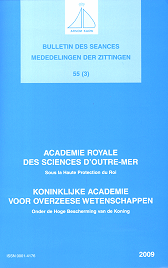 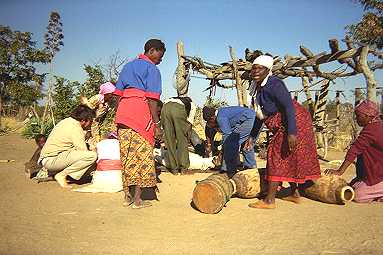
Wim van Binsbergen (crouching, left) during his
final initiation to sangoma, 1991 |
| |
|
|
| Now restored For nearly a decade
Tatashikanda's website on Nkoya society and
culture was a beacon in the cultural life of the
Nkoya people of Western Zambia. In 2012 the
original, free Bravenet hosting expired, and the
Shikanda portal lacked the disk space to
accommodate the Nkoya pages. This has been
remedied now, and the Nkoya
pages are again available under the present link.
However, so far the time has lacked to update the
pages since 2012, although in the meantime many
more new Nkoya-related projects and publications
have come available. Please check Wim van
Binsbergen's / Tatashikanda's current and older
topicalities pages for details
|
 |
|
| January-February,
2015 |
keeping up
the family tradition...
 |
| |
 |
 |
|
installation at Tate
Modern |
earliest
spring in London seen from Tate
Modern |
|
| In February 2015,
Patricia and Wim van Binsbergen
visited London, United Kingdom,
to attend the graduation ceremony
of their middle daughter Sarah
van Binsbergen, who obtained
(with distinction / cum laude) a
Master's Degree in Anthropology
(specialisation: Cultural
Politics) from Goldsmiths
College, University of London One
of Sarah's given names is
Shikanda, which effectively makes
her a Nkoya princess of the
Kahare dynasty, Kaoma district,
Zambia; King Mwene Kahare Kabambi
(1921-1993), the adoptive father
of Sarah's father Tatashikanda,
bestowed the name of his
great-grandmother Queen Shikanda
upon the newborn girl (chiming
the royal bells for the latter in
an ancestral salute), and left
her an estate at his death. One
of Queen Shikanda's praise-names
claims that she gave the
neighbouring Kaonde people a hard
time (by forcefully submitting
them to Mukanda i.e. male puberty
rites including circumcision);
ultimately however her name seems
to derive (like so many other
Nkoya royal names!) from South
Asia -- in this case from that of
the South Asian war deity Skanda
(Kartikeya, Subrahmanya, Murugan,
Kumara, etc.; son of Siva and
brother to Ganesha / Ganypati,
hatched by Ganga / the Ganges
(too hot for any other mode of
birth; cf. the Japanese and the
Finnish fire gods Kagutsuchi),
nurtured by the Pleiades, saviour
of the \world by deating the
demon Taraka, and in some
respects a mythical
transformation of Alexander the
Great) thus testifying to
extensive transcontinental
influence in South Central Africa
during the late 1st and early 2nd
mill. CE. It is even thinkable
that the very name Mukanda
derives from Skanda (which in
South Central African,
Bantu-speaking mouths would be
pronounced shi-kanda anyway),
associated with some so far
unidentified South Asian phallic
cult which happened to tune in
with the widespread custom of
circumcision in sub-Saharan
Africa, cf. the cult of Siva's
lingam which left unmistakable
traces in South Central Africa.
Sarah is not the only one of
Wim van Binsbergen's children to
bear an African name reminiscent
of close personal association in
field-work; how could it be
otherwise, when four of them have
an African-born mother, Patricia,
who over the decades, like
Nezjma's mother before her, has
loyally shared in her husband's
African fieldwork and in the
logistic and emotional turmoil it
has tended to bring about.
Nezjma, Wim's eldest daughter
(left, here shown with her
youngest sister Hannah), was
already early in life
fascinanated by drama, wrote and
directed dozens of children's
plays, and took a diplome in
event organisation. As an infant
she would play on the knees of
the same Mwene Kabambi, in his
palace, and she still cherishes a
small royal bell he gave her in
1973. Her Arabic name however
('star') derives from her
father's North African field-work,
where the original bearer, at age
24 a married mother of four, was
among his principal informants on
shrines and social organisation;
as a result she features
prominently in the field-work
novel Een
Buik Openen ('Opening Up a
Belly') which Wim van
Binsbergen wrote at his daughter
Nezjma's request. Nezjma's
parents visited the Khumiri
field-work site in 1970 together;
on that occasion the origina
Nezjma explained her name to the
pregnant mother and consented
that it should be given to her
friend's unborn child. Like
Sarah, Nezjma has her own special
claims to being 'a child of the
land': North African saints are
venerated in their graves, which
are also the central foci from
which their blessing (baraka) is
being dispensed. Many young
women, especially in the first
years of their marriage when
childbirth is often stagnated,
are taken by their mothers and
mothers-in-law to a major shrine,
where before the tomb they
unloosen the belt that ties their
upper garment (málakhfa) around
the waist; thus opening up,
symbolically at least, to the
saint's baraka and allowing it to
enter their womb, they conceive
of a child (occasionally, but not
in this case, aided by the
shrine's living warden) that in
all respects is counted as the
saint's offspring. Nezjma's
pregnant mother was persuaded to
submit to the same rite, and thus
the child rightfully became 'bint
as-sîdî Mhammad'. To
commemorate this special link
with the saint, our family has
every since, for nearly half a
century now, observed the
semi-annual festival (zerda) of
Sidi Mhammad, by dedicating a
Khumiri meal of kuskus and hallal
meat to his name.
|
 |
| |

|

|

|
| |
Wim's eldest son
Vincent ('Victorious') lacks a
field-work name, his last given
name however derives from Matthew
Schoffeleers (his father's
long-standing colleague, PhD
supervisor and officiant in his
parent's wedding ), and his
main name recalls his parents'
victory over their variously
troubled childhood; after taking
a BSc in physical education
Vincent became an operational
sales manager and a great
sportsman, in which capacity he
has a most stimulating influence
on his father (see picture) |
Wim's youngest
son Dennis appears on some of the
other entries for 2015. While
ultimately named after the
Ancient Greek god of intoxication
and ecstasy Dionysos who (reputed
to lead an army into India) in
many respects is the counterpart
of Skanda, he was specifically
named after his father's adoptive
elder brother and research
assistant over the decades,
Dennis Shiyowe, of the Nkoya
people, Zambia; Mr Shiyowe, who
is now a headman and a church
leader, is shown here at the
Kazanga Festival, 2011. |
Wim's
youngest daughter is Hannah; she
is reading philosophy, did a BA
thesis on Derrida and dreams, nd
is a prominent young poetess. Her
given African name is Sebuka --
not a person, but the name the
Kalanga / Ndebele diviners
of Southern Africa have given to
the penultimate one of the 16
combinations in the Hakata
four-tablet oracle, meaning
'it is a group, completeness' (of
the sibling group). The name is
all the more fitting since also
the Hakata tablets are modelled
after a kinship idiom: the
nucleus of (from left to right)
Senior Woman, Senior Man, Junior
Woman, Junior Man. |
|
| |
|
Throughout 2014 and in the
early months of 2015 Wim van Binsbergen
has worked on a number of writing
projects, of which the final results are
to be expected in 2015. Some of these
have already been announced in this
webpage amd are now in the press,
e.g.
- Our drums are always on my mind:
Nkoya history, culture and
society (here also the recent,
Dutch-language study on Mabombola
Village will appeared in an
English version;
- Sangoma Science: From ethnography
to intercultural ontology:
Towards a poetics of the
globalising exploration into
local spiritualities
- Shimmerings of the Rainbow
Serpent: Towards the
interpretation of crosshatching
motifs in Palaeolithic art:
Comparative mythological and
archaeoastronomical explorations
inspired by the incised Blombos
red ochre block, South Africa, 70
ka BP, and Nkoya female puberty
rites, 20th c. CE.’,
- Rethinking Africa's
transcontinental continuities in
pre- and protohistory (a
collective volume based on the
valedictory conference offered to
Wim van Binsbergen on the
occcasion of his retirement from
the African Studies Centre,
Leiden, 2012);
- Joseph Karst: As pioneer of
long-range approaches to
Mediterranean Bronze-Age
ethnicity -- with a special
chapters on the global
distribution and reconstructed
global history of headhunting
- Sun cults in Africa and beyond:
Aspects of the hypothetical
Pelasgian heritage? Grafton
Elliot Smith's 'Heliolithic
Culture' revisted after a hundred
years
- Towards The Pelasgian Hypothesis:
An integrative perspective on
ethnic, cultural, linguistic and
genetic affinities proposed to
encompass Africa, Asia and Europe
from the Neolithic onwards
These books are now in the press,
their editing is being finalised, they
have been issued with ISBNs, and they are
expected to by published within the next
two years
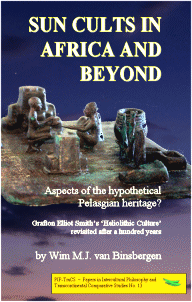 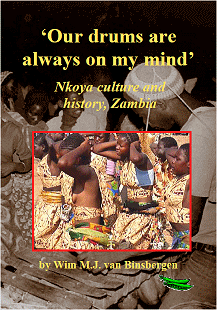
|
|
| |
| In
this period the publishing activities of Shikanda
Press were further rationalised and the marketing
gradually improved due to the efforts of Dennis
van Binsbergen, who after completing his BA
in Marketing and Languages has now
temporarily joined Shikanda Press on an
internship as Marketing Director. |
| |
| Nu
gepubliceerd: Wim van Binsbergen, 2015, Een
lekker sodemietertje: Een kind op weg naar de
poëzie (autobiografie 1947-1963), Haarlem:
Shikanda, 168 pp.,
VOORLOPIG ONDER TOTAAL EMBARGO VANWEGE DE
PIJNLIJKE FAMILIE- GEHEIMEN DIE ERIN AAN DE ORDE
GESTELD WORDEN
|
| |
| Nu
gepubliceerd: Wim
van Binsbergen, 2015, Verspreide gedichten
1961-2015: Door aantekeningen samengebonden,
Haarlem: Shikanda, 209 pp.
gebruik de volgende button om te bestellen bij
de distributeurs (Lulu) / use this link to order
with the distributors (Lulu):
EUR20,90 / US$ 23
 
or try other distributors e.g. Amazon.com
|
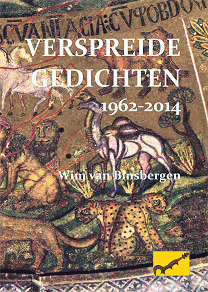 |
| |
| in
January 2015, Wim and Patricia van Binsbergen
made another visit to the Cape Verde Islands
(like in early 2014), where editorial work was
undertaken, and where they refreshed their
command of the Creole / Kriulu language, which
they first learned during their fieldwork in
Guinea-Bissau, 1983 |
click
here for a page of pictures showing this utterly
barren volcanic island |
|
| 2015 begins
above this line |
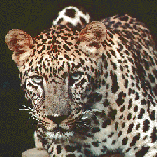


![]() ; major entries will be separated by a
light green beam:
; major entries will be separated by a
light green beam: ![]() ; abstracts and blurbs appear against a light blue
background.
; abstracts and blurbs appear against a light blue
background. 

